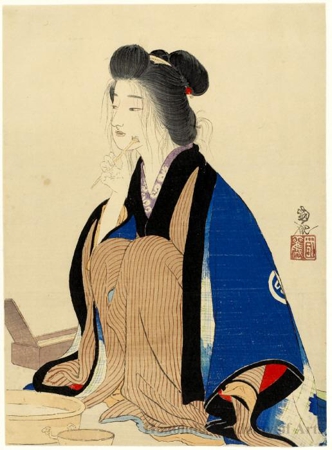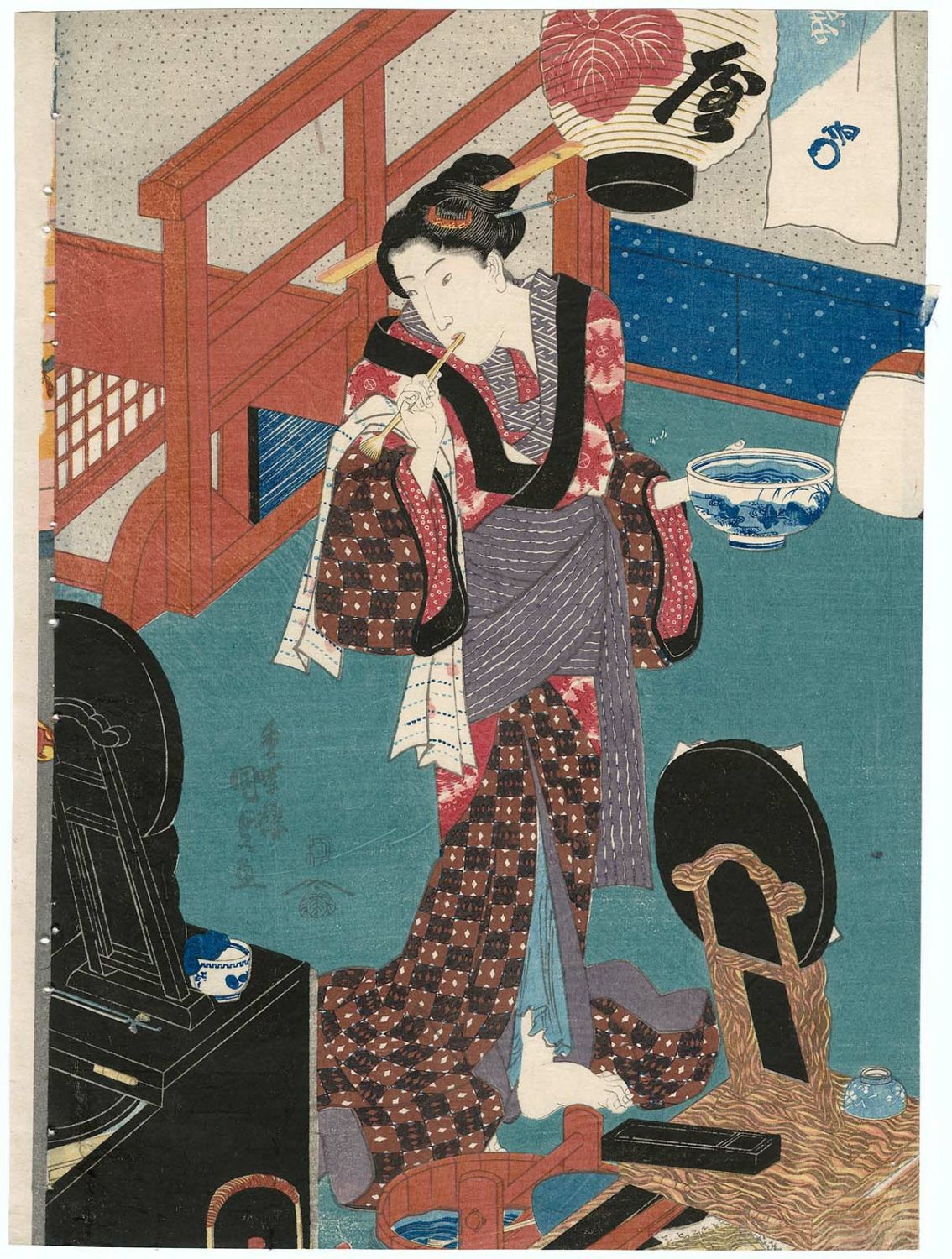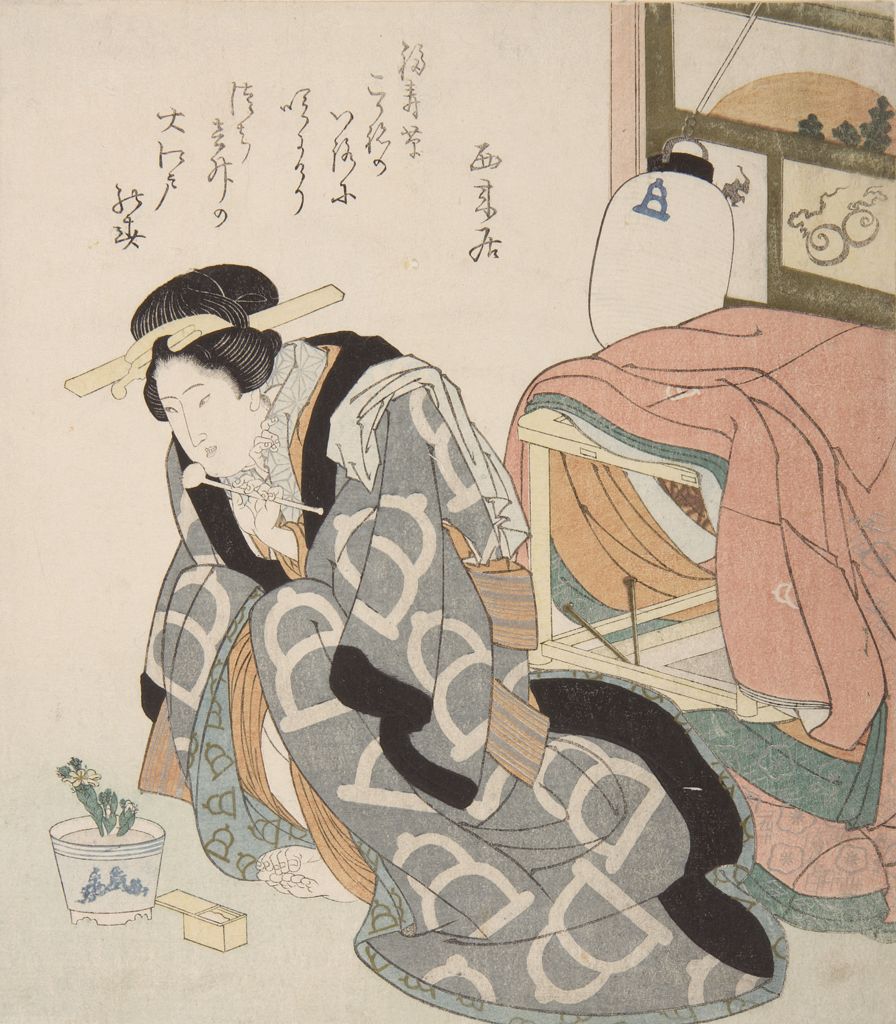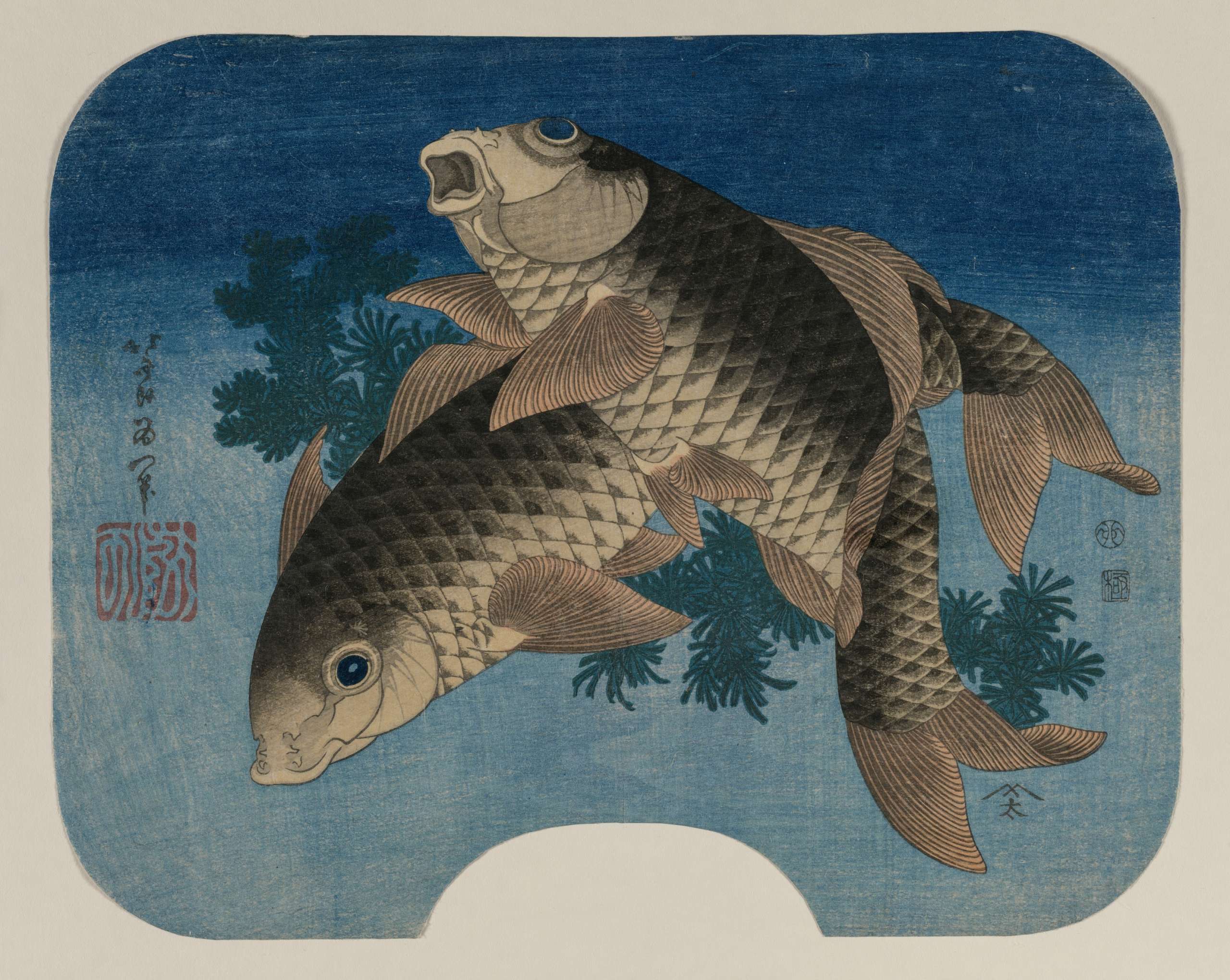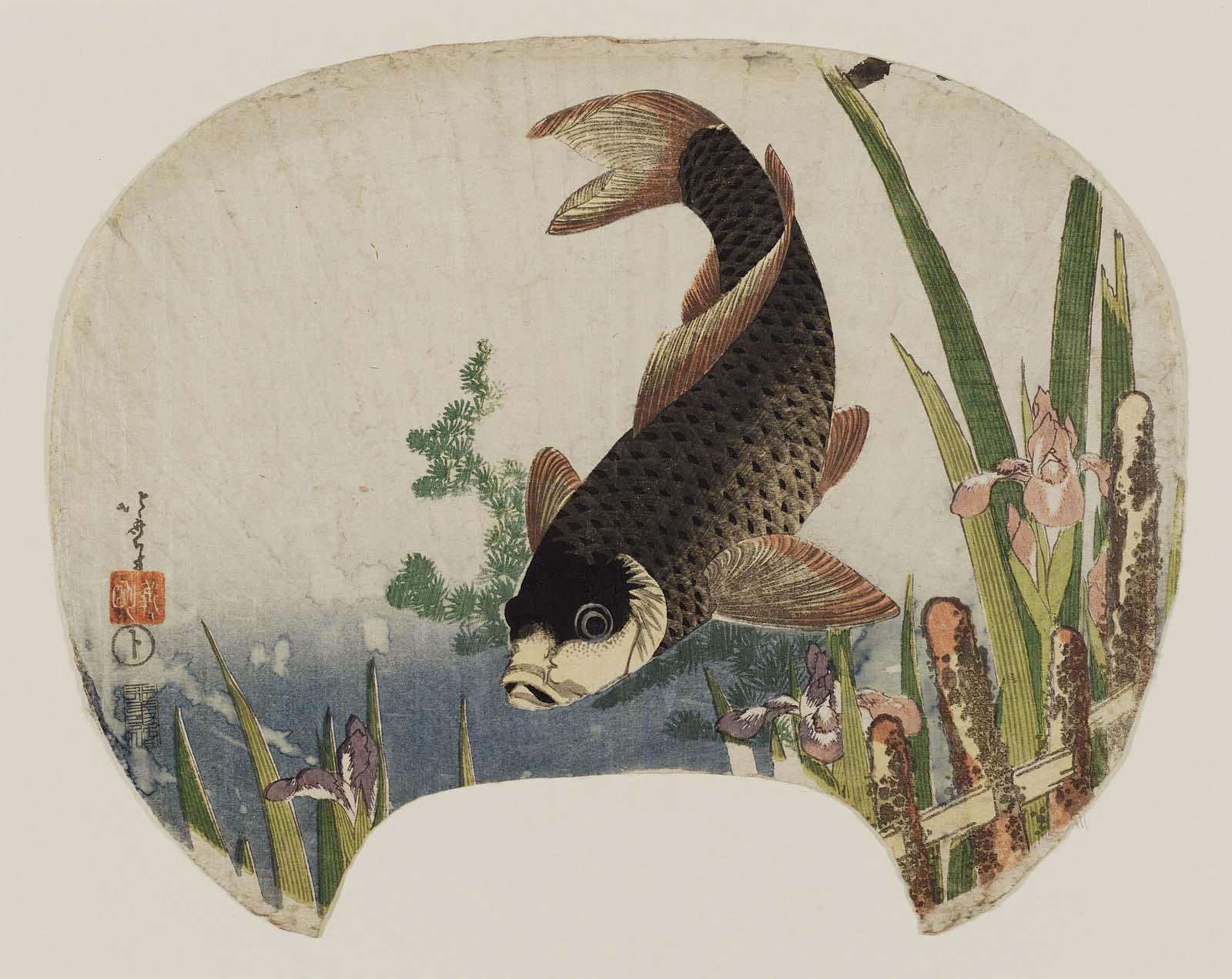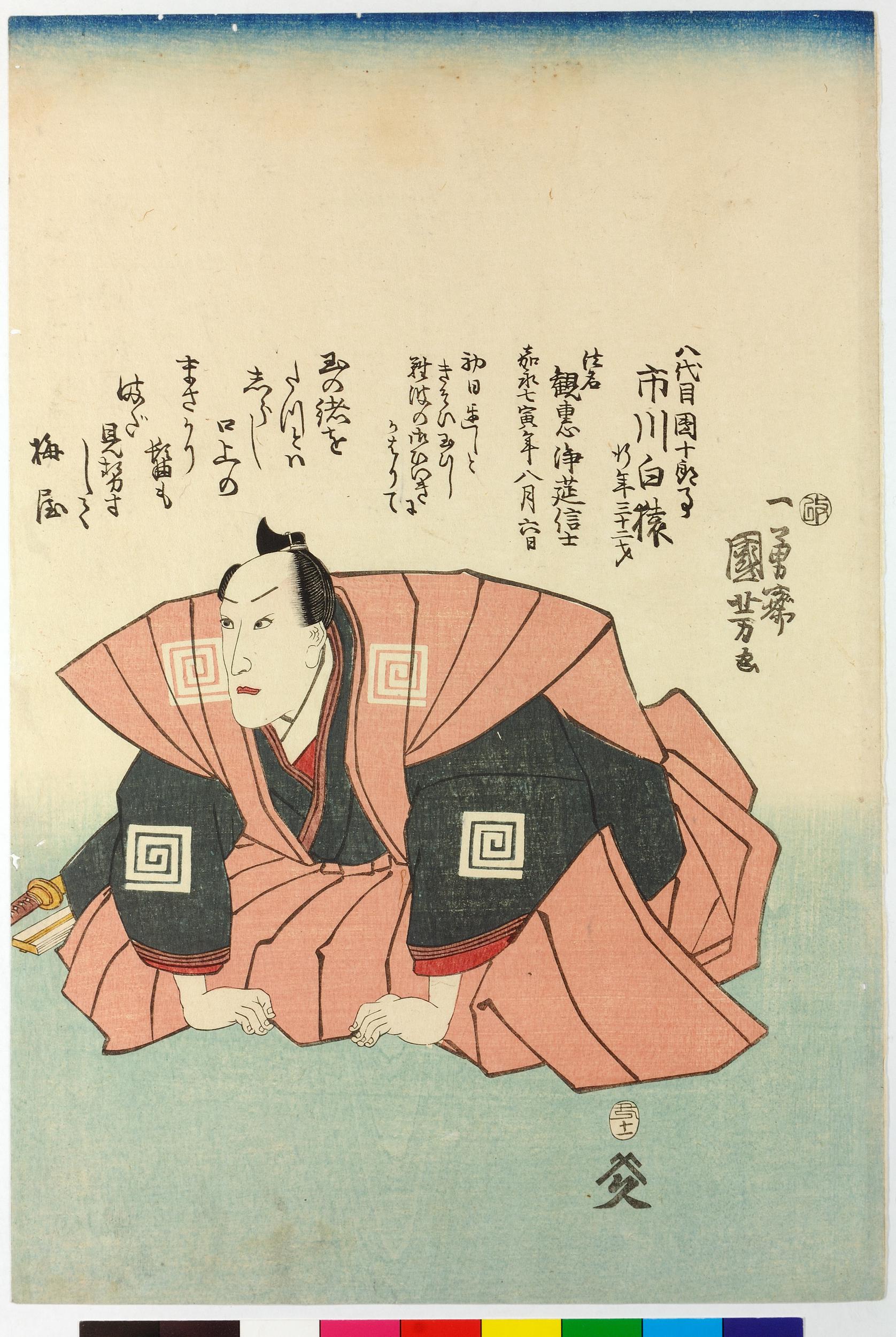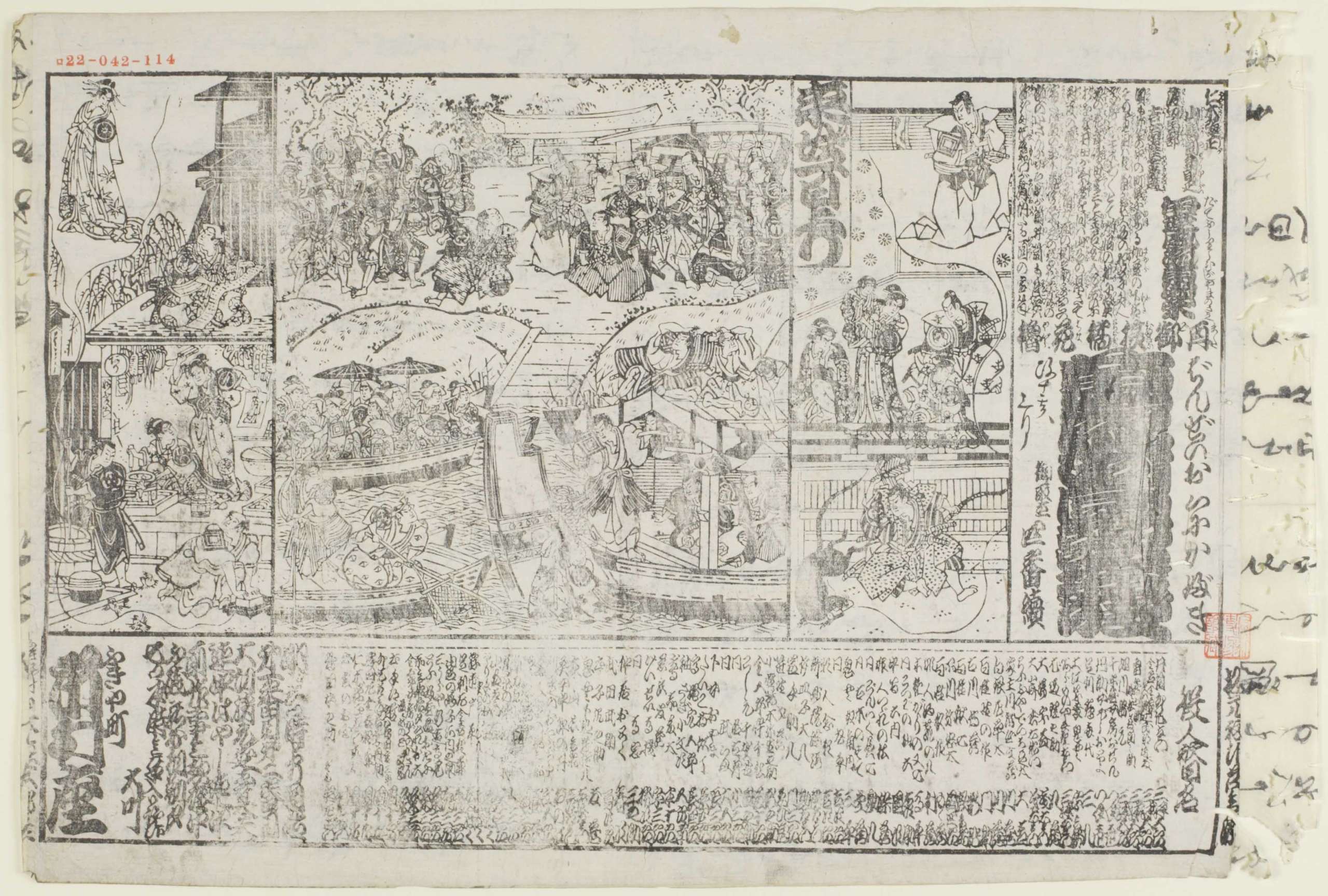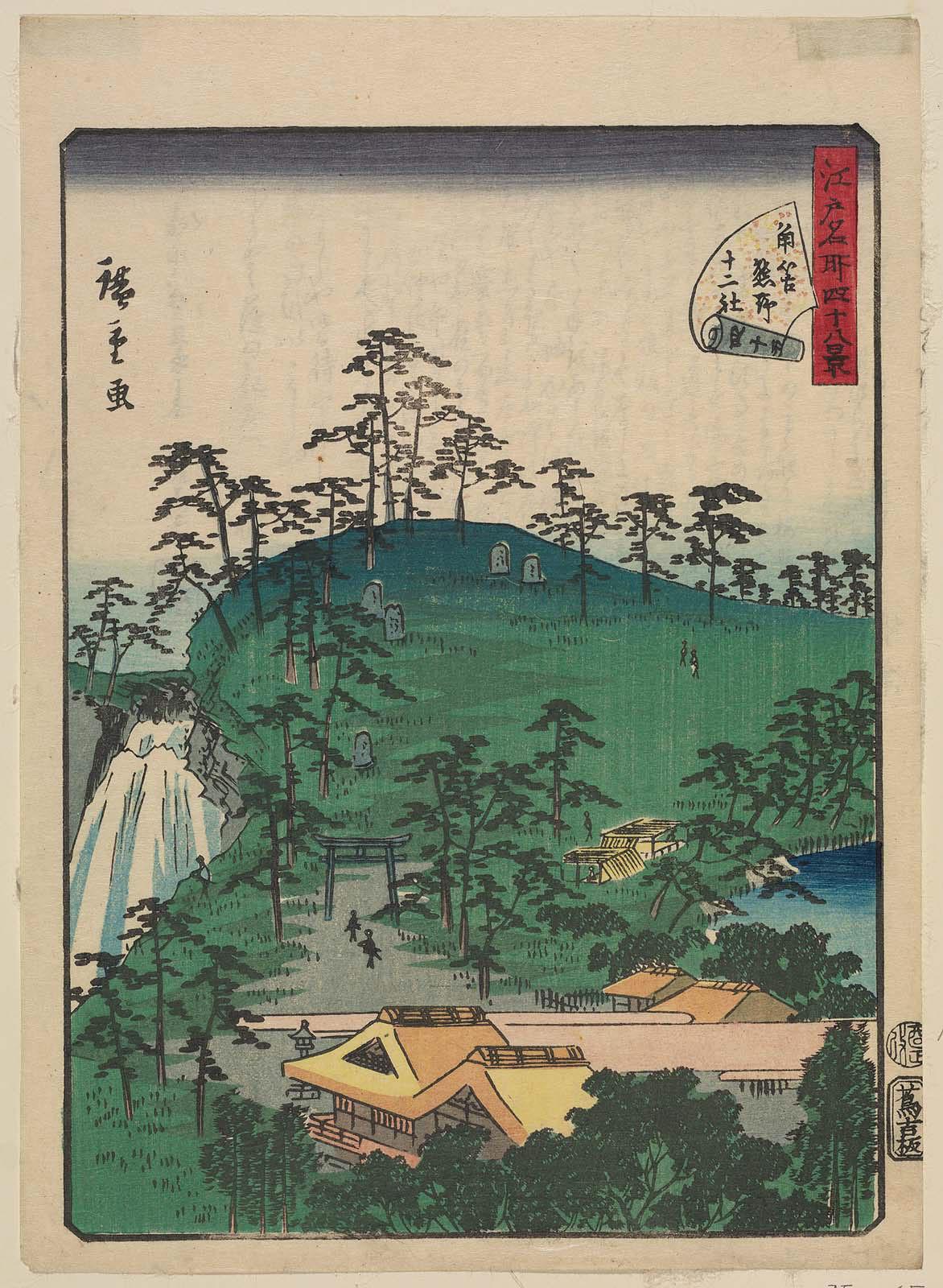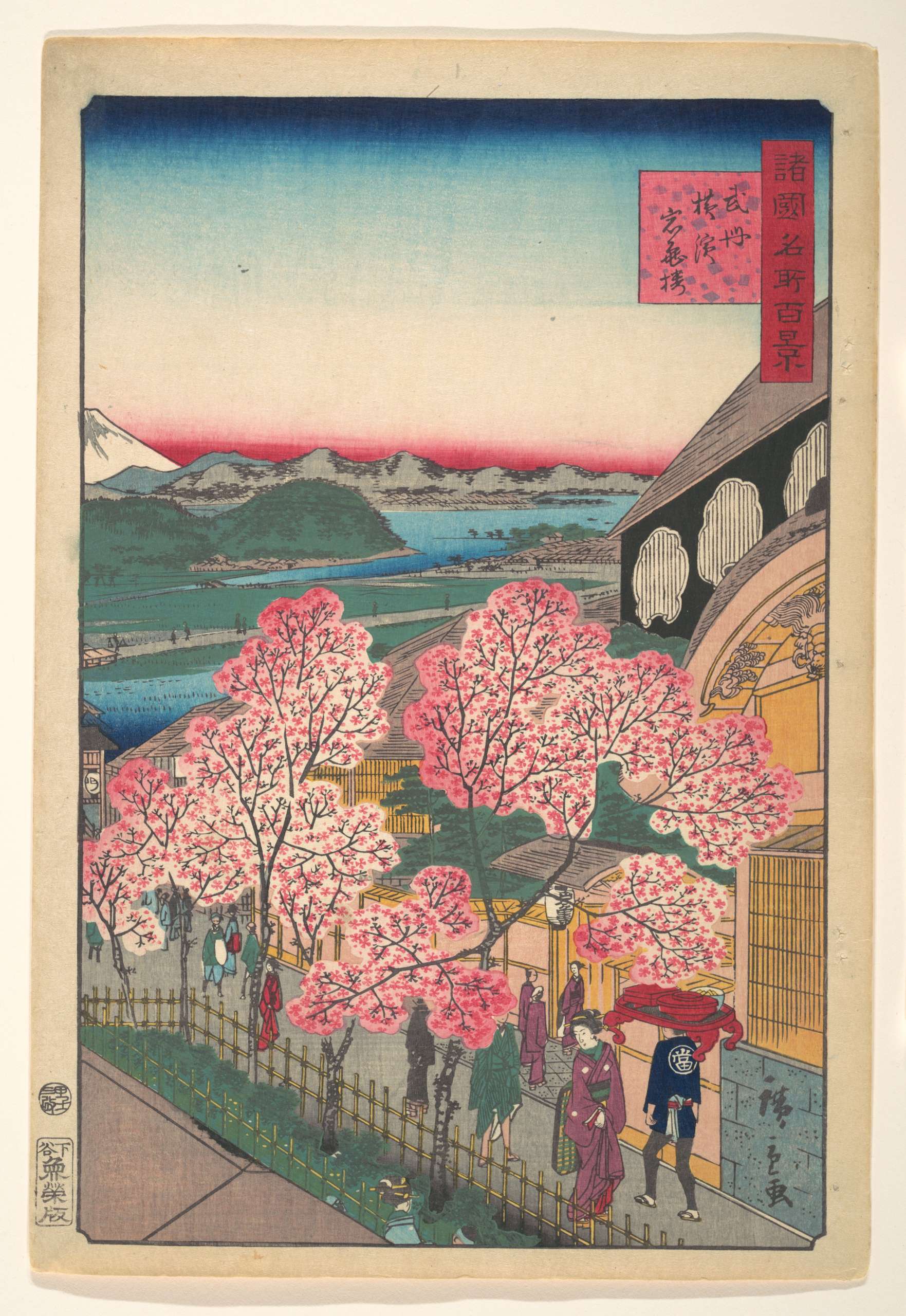-
 NEWArtist: Utagawa Kuniyoshi (歌川国芳) (1797–1861) Signed: 一勇斎 (Ichiyūsai) in a yellow cartouche, 國芳画 (Kuniyoshi ga) in a red cartouche Publisher: 未詳 (Yama-Ta), seal [板元, 太] – Hanmoto, Ta; Marks 19-044 | U421b Censor Seal: Aratame + Ansei 3 (3rd lunar month, 1856) Block Carver: 彫竹 (Hori Take), identified as Yokokawa Takejirō (横川竹二郎) (fl. 1845–1863) Media: Rigid fan print (Aiban Yoko-e Uchiwa-e, 合判横絵 団扇絵), 227 × 286 mm Half-length portrait of a high-ranking courtesan (oiran, 花魁) seated in a three-quarter view, holding a porcelain sake cup decorated with a blue mon of stylized oak leaves (kashiwa, 柏). She gazes downward at a partially unrolled letter resting on her lap. Her elaborate hairstyle, adorned with multiple kogai (ornamental hairpins) featuring golden floral motifs, signifies her elevated status within her profession. Her layered kimono displays a combination of red, blue, and black geometric patterns, emphasizing the luxurious textiles associated with courtesans of her rank. The stylized oak leaves on the sake cup may allude to the family mon of Onoe family of kabuki actors, evoking the overlap between theatre and the pleasure quarters. The background portrays a night scene in the Yoshiwara Pleasure District (吉原), where figures move beneath lantern-lit buildings, showing the vibrant nightlife of Edo.
NEWArtist: Utagawa Kuniyoshi (歌川国芳) (1797–1861) Signed: 一勇斎 (Ichiyūsai) in a yellow cartouche, 國芳画 (Kuniyoshi ga) in a red cartouche Publisher: 未詳 (Yama-Ta), seal [板元, 太] – Hanmoto, Ta; Marks 19-044 | U421b Censor Seal: Aratame + Ansei 3 (3rd lunar month, 1856) Block Carver: 彫竹 (Hori Take), identified as Yokokawa Takejirō (横川竹二郎) (fl. 1845–1863) Media: Rigid fan print (Aiban Yoko-e Uchiwa-e, 合判横絵 団扇絵), 227 × 286 mm Half-length portrait of a high-ranking courtesan (oiran, 花魁) seated in a three-quarter view, holding a porcelain sake cup decorated with a blue mon of stylized oak leaves (kashiwa, 柏). She gazes downward at a partially unrolled letter resting on her lap. Her elaborate hairstyle, adorned with multiple kogai (ornamental hairpins) featuring golden floral motifs, signifies her elevated status within her profession. Her layered kimono displays a combination of red, blue, and black geometric patterns, emphasizing the luxurious textiles associated with courtesans of her rank. The stylized oak leaves on the sake cup may allude to the family mon of Onoe family of kabuki actors, evoking the overlap between theatre and the pleasure quarters. The background portrays a night scene in the Yoshiwara Pleasure District (吉原), where figures move beneath lantern-lit buildings, showing the vibrant nightlife of Edo. -
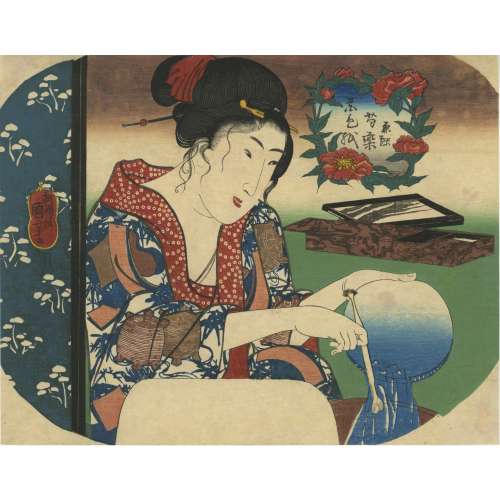 NEWPeonies (Shakuyaku) [芍薬] Series: Flower-Colored Papers (Hana Shikishi) [花色紙] Artist: Utagawa Kuniyoshi [歌川 國芳] (Japanese, 1798–1861) Signature: Chō-ō-rō Kuniyoshi ga (朝櫻楼 國芳 画) Publisher: Kojimaya Jūbei [小島屋 十兵衛] (Japanese, 1797 – 1869); seal 十, Marks 06-014 | 264a Date/Censorship Approval: Nanushi seal Yoshimura (吉村) for Yoshimura Gentarō (吉村 源太郎), VI/1843–XI/1846. Medium: Rigid fan print (Aiban Yoko-e Uchiwa-e, 合判横絵 団扇絵), 222 x 284 mm.
NEWPeonies (Shakuyaku) [芍薬] Series: Flower-Colored Papers (Hana Shikishi) [花色紙] Artist: Utagawa Kuniyoshi [歌川 國芳] (Japanese, 1798–1861) Signature: Chō-ō-rō Kuniyoshi ga (朝櫻楼 國芳 画) Publisher: Kojimaya Jūbei [小島屋 十兵衛] (Japanese, 1797 – 1869); seal 十, Marks 06-014 | 264a Date/Censorship Approval: Nanushi seal Yoshimura (吉村) for Yoshimura Gentarō (吉村 源太郎), VI/1843–XI/1846. Medium: Rigid fan print (Aiban Yoko-e Uchiwa-e, 合判横絵 団扇絵), 222 x 284 mm.Interpretation of the Inscription in the Floral Cartouche
- 花色紙 (Hana Shikishi) – "Flower-Colored Paper" or "Decorative Shikishi Paper with Floral Motifs"
- 芍薬 (Shakuyaku) – "Peony", a flower symbolizing prosperity, beauty, and romance in Japanese culture
- 団扇絵 (Uchiwa-e) – "Round Fan Illustration" or "Picture on an Uchiwa (rigid fan)"
Description & Symbolic Analysis
This print, part of the Hana Shikishi (Flower-Colored Papers) series, depicts a woman washing a basin after brushing her teeth. She is positioned behind an indigo-colored folding screen, adorned with a repeating pattern of distant pines, presented in reverse printing technique (wyabori, 捺ぼり). The screen is a visual separator, adding depth and an intimate atmosphere to the scene. The woman is portrayed in a three-quarter view, facing left, her face delicately contoured. She is dressed in a safflower-dyed kimono (furisode, 振袖) featuring an asanoha (麻の葉, hemp leaf) shibori pattern, a motif often associated with purity and protection. Over this, she wears an outer garment decorated with an indigo bamboo motif, symbolizing strength and resilience. Additionally, the garment features:- Double gourd (瓢箪, hyōtan) symbolises longevity, fertility, and good fortune.
- Strips of paper resembling “next-morning letters” (kinuginu no fumi, 衣衣の文) – These evoke romantic correspondence or the written wishes of the Tanabata festival.
- Spools or reels of thread (chikiri, 糸巻き) – A motif reminiscent of Tanabata festival themes, often linked to the celestial lovers Orihime and Hikoboshi. The phonetic pun with chigiri (契り, vow or romantic promise) reinforces themes of marriage, fate, and lifelong bonds.
Adornment & Hairstyling
Her elaborate hairstyle features a red hair tie (musubi, 結び), signifying youth and romantic allure. It is further adorned with:- Golden kogai (笄) – A decorative hairpin, often used by courtesans or high-ranking women.
- Tama kanzashi (玉簪) – A ball-tipped ornamental hairpin, reinforcing her refined status.
Objects in the Scene & Their Symbolism
The woman is holding a traditional Japanese toothbrush (fusa-yōji, ふさ楊枝) in her right hand, while pouring out water from the basin after brushing her teeth. This act symbolizes purity and preparation for intimacy. To her right, an ornate lacquered writing box (suzuribako, 硯箱) is placed near an inkstone (硯, suzuri). This object could also be interpreted as a dreamstone (梦石, mèng shí), a scholar’s object associated with nostalgia, love, or secret communication.Context in Ukiyo-e Tradition
Tooth brushing was uncommon in bijin-ga (美人画, "beautiful woman prints"). Ukiyo-e frequently depicted women engaging in personal grooming rituals, reflecting ideals of elegance and self-care in Edo-period culture.
Two additional fan prints from the Hana Shikishi series have been identified and can be found at the Kuniyoshi Project website:- Morning Glory (Asagao, 朝顔)
- Clematis (Tessen, 鉄線)
These prints, like Peonies (Shakuyaku), emphasize seasonal beauty and feminine refinement, themes central to Kuniyoshi’s bijin-ga oeuvre.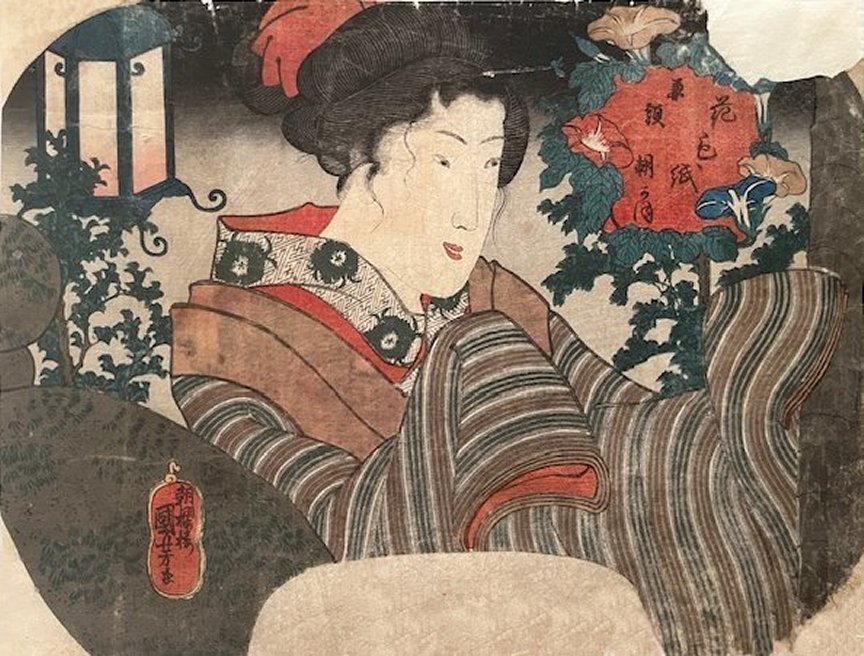
Morning Glory (Asagao, 朝顔)
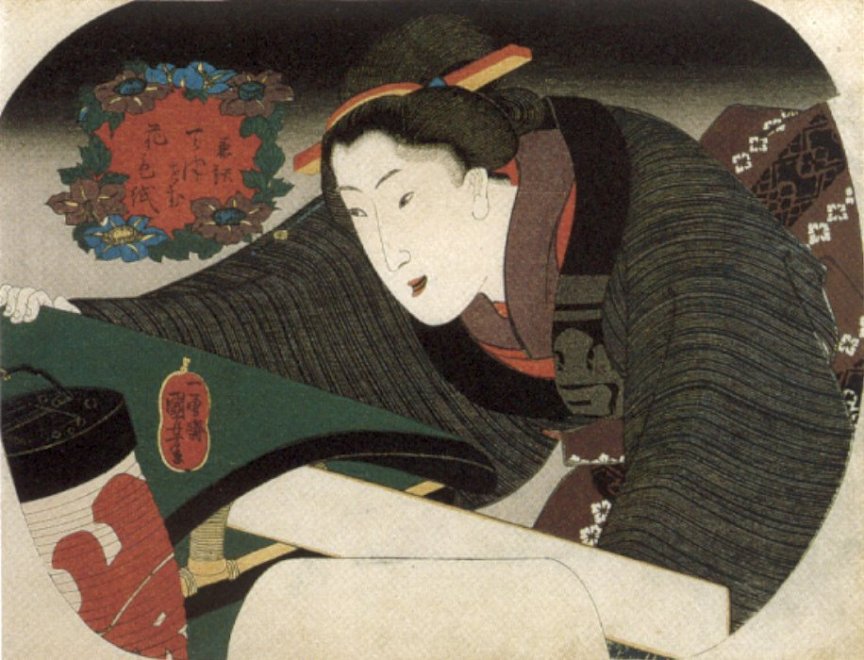
Clematis (Tessen, 鉄線)
-
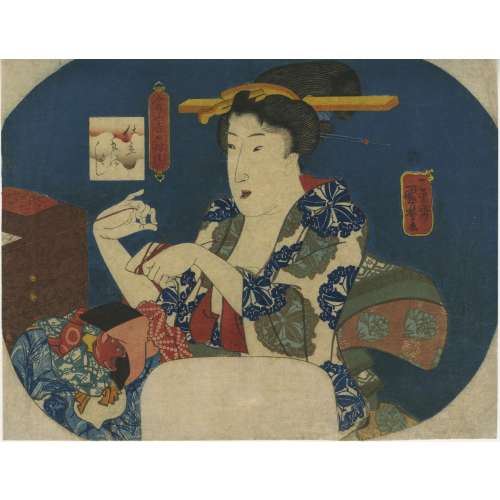 NEW
NEWA half-length portrait of a woman seated in an interior, winding red thread, dressed in a richly decorated kimono featuring intricate floral motifs in blue, green, and brown hues with a red underlayer. Her elaborately styled hair is adorned with a yellow comb and multiple hairpins. To her left is a partially visible wooden chest of drawers, to which a piece of red paper bearing calligraphy is affixed. A puppet or doll dressed in a patterned kimono with a striking red-painted face rests on her lap or a surface before her.
An uncut fan print (aiban yoko-e uchiwa-e) entitled “Good tailoring” or “Good sewing [仕立ものよし] (shitate monoyoshi)” from the series "It’s an Auspicious Day to…" [最上吉日つくし] (Saijō [no] kichijitsu tsukushi).
Artist: Utagawa Kuniyoshi [歌川 國芳] (Japanese, 1798 – 1861).
Signature: Ichiyûsai Kuniyoshi giga (一勇斎 國芳戯画, playfully drawn by Ichiyûsai Kuniyoshi).
Publisher: Enshūya Matabei [遠州屋又兵衛] (Enterprise, active c. 1768 – 1881); seal: "to" (ト) under roof (Marks 01-031 | 057a). Nanushi seal Watari (渡) for Watanabe Shōemon, VI/1842-V 1c/1846. Media: Fan print (uchiwa-e, 団扇絵), 224 x 290 mm. Reference: (1) Kuniyoshi project; (2) Tokyo Museum Digital Archive [Thanks to Horst Greabner] -
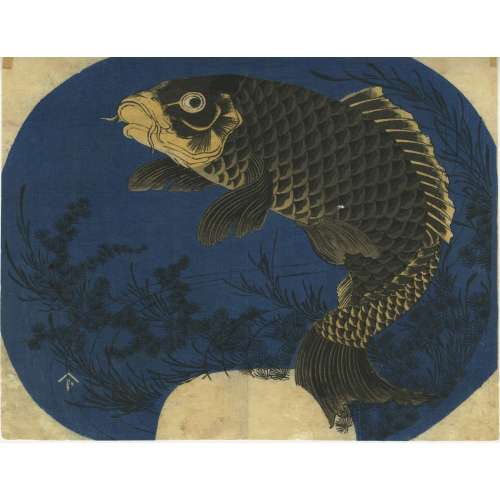 NEWAn uncut fan print depicting a carp (koi) swimming amid aquatic plants against a deep blue background. Artist: unknown/unsigned, possibly Katsushika Hokusai [葛飾 北斎] (Japanese, 1760 – 1849). Publisher: Enshūya Matabei [遠州屋又兵衛] (Japanese, fl. c. 1768 – 1881) Date: No date seal, no censor seal (privately printed?) Media: Fan print (uchiwa-e, 団扇絵), 224 x 290 mm. Similar subject:
NEWAn uncut fan print depicting a carp (koi) swimming amid aquatic plants against a deep blue background. Artist: unknown/unsigned, possibly Katsushika Hokusai [葛飾 北斎] (Japanese, 1760 – 1849). Publisher: Enshūya Matabei [遠州屋又兵衛] (Japanese, fl. c. 1768 – 1881) Date: No date seal, no censor seal (privately printed?) Media: Fan print (uchiwa-e, 団扇絵), 224 x 290 mm. Similar subject: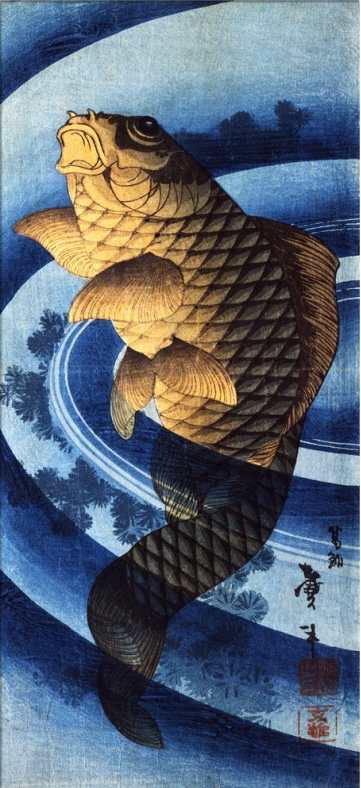
Katsushika TAITO II (fl. c. 1810-53)
-
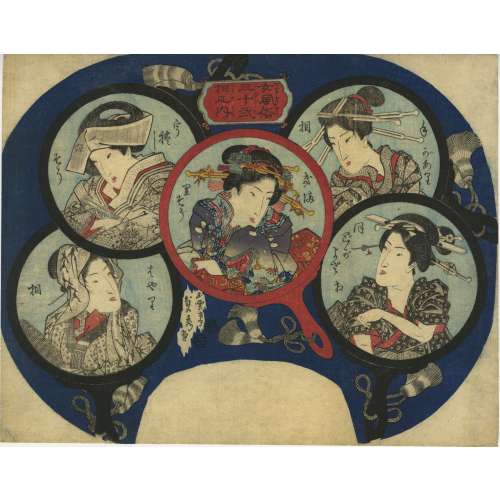 NEWArtist: Utagawa Sadahide [歌川貞秀] (Japanese, 1807 – 1879). Signed: Gountei Sadahide ga [五雲亭貞秀画] (Picture by Gountei Sadahide). Publisher: Ibaya Senzaburō [伊場屋仙三郎] (Japanese, c. 1815 – 1869); seal 三 in a circle Published: 1830s – no date seal, no censor seal (privately printed?) Media: Fan print (uchiwa-e, 団扇絵), 235 x 298 mm Inscriptions in kanji with furigana readings: Top right: "The Handy Type" (手があり相, te ga ari sō) – A composed woman adjusting her clothing. Bottom right: "Images of Manners" (風ぞくが, fūzokuga) – Possibly referring to depictions of etiquette or courtesan behaviour. The additional phrase 宵闇 (yoyami) 相 (sō) suggests a connection to nighttime activities. Centre: "The Proper Type" (きまり相, kimari sō) – A well-dressed woman seated elegantly, signifying a composed demeanour. Top left: Unclear reading (ほう☆し そう or ☆ほし そう) – Possibly related to 奉仕 (hōshi, "service" or "devotion"), implying attentiveness or subservience. Bottom left: "The Popular Type" (はやり相, hayari sō) – A fashionable woman wearing a partially veiled head covering, reflecting contemporary trends. Thanks to Horst Graebner.
NEWArtist: Utagawa Sadahide [歌川貞秀] (Japanese, 1807 – 1879). Signed: Gountei Sadahide ga [五雲亭貞秀画] (Picture by Gountei Sadahide). Publisher: Ibaya Senzaburō [伊場屋仙三郎] (Japanese, c. 1815 – 1869); seal 三 in a circle Published: 1830s – no date seal, no censor seal (privately printed?) Media: Fan print (uchiwa-e, 団扇絵), 235 x 298 mm Inscriptions in kanji with furigana readings: Top right: "The Handy Type" (手があり相, te ga ari sō) – A composed woman adjusting her clothing. Bottom right: "Images of Manners" (風ぞくが, fūzokuga) – Possibly referring to depictions of etiquette or courtesan behaviour. The additional phrase 宵闇 (yoyami) 相 (sō) suggests a connection to nighttime activities. Centre: "The Proper Type" (きまり相, kimari sō) – A well-dressed woman seated elegantly, signifying a composed demeanour. Top left: Unclear reading (ほう☆し そう or ☆ほし そう) – Possibly related to 奉仕 (hōshi, "service" or "devotion"), implying attentiveness or subservience. Bottom left: "The Popular Type" (はやり相, hayari sō) – A fashionable woman wearing a partially veiled head covering, reflecting contemporary trends. Thanks to Horst Graebner. -
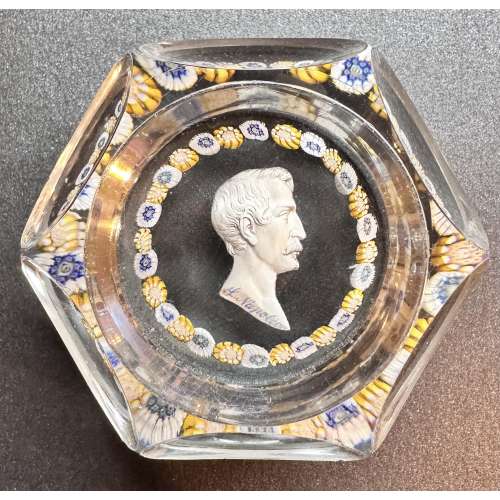 NEWTransparent colourless lead glass paperweight with sulphide portrait of Napoléon III undersigned 'L.Napoléon' in a millefiori circle. Character: Napoleon III, Charles-Louis Napoléon Bonaparte (French, 1808 – 1873) Maker: Compagnie des Cristalleries de Saint Louis, Saint-Louis-lès-Bitche, département Moselle, région Grand Est.
NEWTransparent colourless lead glass paperweight with sulphide portrait of Napoléon III undersigned 'L.Napoléon' in a millefiori circle. Character: Napoleon III, Charles-Louis Napoléon Bonaparte (French, 1808 – 1873) Maker: Compagnie des Cristalleries de Saint Louis, Saint-Louis-lès-Bitche, département Moselle, région Grand Est. -
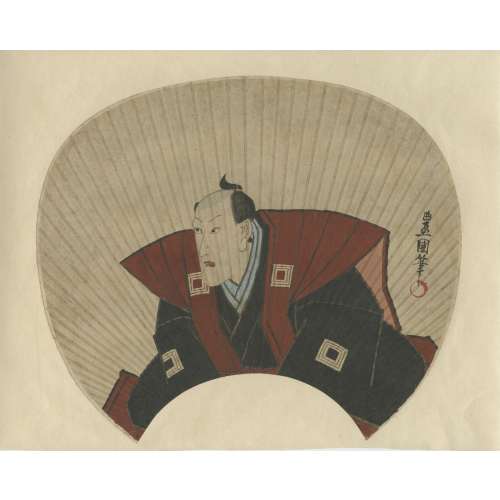 NEWRigid uchiwa fan, ink and colour on paper. Kabuki actor Ichikawa Danjūrō VIII in a crimson red robe, on his knees in a ceremonial bowing position to the audience during a formal stage announcement before the performance (Kojo, 口上). The fan has been used, dismounted from the frame, and laid onto Japanese paper, hence the rib marks. Painted c. 1850. Ichikawa Danjūrō VIII [市川団十郎] (Japanese, 1823 – 1854); other names: Ichikawa Ebizō VI, Ichikawa Shinnosuke II. Artist: Utagawa Kunisada [歌川 国貞], a.k.a. Utagawa Toyokuni III [三代 歌川 豊国] (Japanese, 1786 – 1865). Signed: Toyokuni hitsu [豊国筆] with red toshidama seal. Dimensions: 280 x 325 mm Reference: Ichikawa Danjūrō VIII by Utagawa Kuniyoshi 歌川国芳, 1855.
NEWRigid uchiwa fan, ink and colour on paper. Kabuki actor Ichikawa Danjūrō VIII in a crimson red robe, on his knees in a ceremonial bowing position to the audience during a formal stage announcement before the performance (Kojo, 口上). The fan has been used, dismounted from the frame, and laid onto Japanese paper, hence the rib marks. Painted c. 1850. Ichikawa Danjūrō VIII [市川団十郎] (Japanese, 1823 – 1854); other names: Ichikawa Ebizō VI, Ichikawa Shinnosuke II. Artist: Utagawa Kunisada [歌川 国貞], a.k.a. Utagawa Toyokuni III [三代 歌川 豊国] (Japanese, 1786 – 1865). Signed: Toyokuni hitsu [豊国筆] with red toshidama seal. Dimensions: 280 x 325 mm Reference: Ichikawa Danjūrō VIII by Utagawa Kuniyoshi 歌川国芳, 1855. -
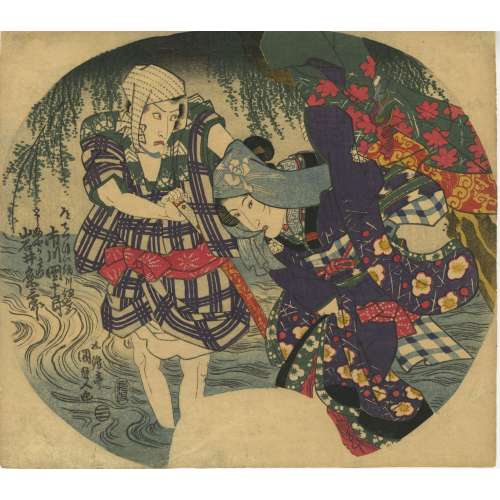 NEWIchikawa Danjūrō VII [市川団十郎] and Iwai Kumesaburō II [岩井粂三郎] as Kinugawa Iemon [絹川伊右衛門] and Tōfuya Kasane [とうふやヶさね], resp., in kabuki play Banzei okuni kabuki [万歳阿国歌舞妓], performed at Ichimura Theatre [市村座] on March, 21, 1827. References: Kunisada Project; Waseda University. Ichikawa Danjūrō VII [市川団十郎] (Japanese, 1791 – 1859); other names: Ichikawa Ebizō V, Ichikawa Hakuen II, Ichikawa Shinnosuke I. Iwai Hanshirō VI [[岩井半四郎] (Japanese, 1799 – 1836); other names: Iwai Hanshirō VI, Iwai Kumesaburō II, Iwai Hisajirō I, Baiga (poetry name), Shūka (poetry name). Artist: Utagawa Kunisada [歌川 国貞], a.k.a. Utagawa Toyokuni III [三代 歌川 豊国] (Japanese, 1786 – 1865). Signed: Gototei Kunisada ga [五渡亭國貞画]. Publisher: Ibaya Senzaburō [伊場屋仙三郎] (Japanese, fl. 1790s-1860s). Date seal and aratame seal: boar (亥), Bunsei 10 – 1827. Untrimmed fan print (aiban yoko-e uchiwa-e), 235 x 270 mm. Ichimura-za Kabuki Playbill (Tsuji banzuke):
NEWIchikawa Danjūrō VII [市川団十郎] and Iwai Kumesaburō II [岩井粂三郎] as Kinugawa Iemon [絹川伊右衛門] and Tōfuya Kasane [とうふやヶさね], resp., in kabuki play Banzei okuni kabuki [万歳阿国歌舞妓], performed at Ichimura Theatre [市村座] on March, 21, 1827. References: Kunisada Project; Waseda University. Ichikawa Danjūrō VII [市川団十郎] (Japanese, 1791 – 1859); other names: Ichikawa Ebizō V, Ichikawa Hakuen II, Ichikawa Shinnosuke I. Iwai Hanshirō VI [[岩井半四郎] (Japanese, 1799 – 1836); other names: Iwai Hanshirō VI, Iwai Kumesaburō II, Iwai Hisajirō I, Baiga (poetry name), Shūka (poetry name). Artist: Utagawa Kunisada [歌川 国貞], a.k.a. Utagawa Toyokuni III [三代 歌川 豊国] (Japanese, 1786 – 1865). Signed: Gototei Kunisada ga [五渡亭國貞画]. Publisher: Ibaya Senzaburō [伊場屋仙三郎] (Japanese, fl. 1790s-1860s). Date seal and aratame seal: boar (亥), Bunsei 10 – 1827. Untrimmed fan print (aiban yoko-e uchiwa-e), 235 x 270 mm. Ichimura-za Kabuki Playbill (Tsuji banzuke): -
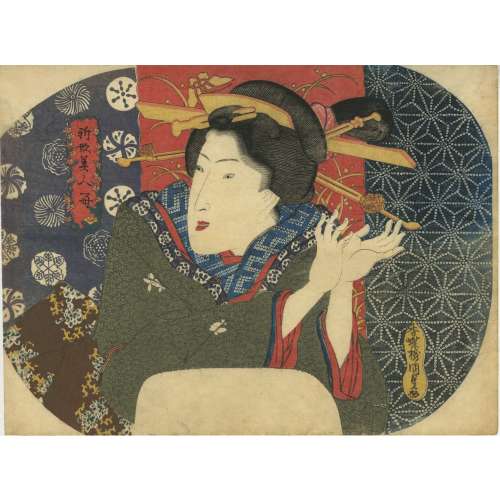 NEWHalf-length portrait of a beautiful young woman wearing a chrysanthemum-patterned green kimono, face directed 3/4 to the right, holding her hands together and fingers spread, arranging the hairpins in her elaborate hairdo; garments of different colours and pattern designs on the background. Series: The taste of the new type of woman (Shingata bijin konomi) [新形美人好]. Artist: Utagawa Kunisada [歌川 国貞], a.k.a. Utagawa Toyokuni III [三代 歌川 豊国] (Japanese, 1786 – 1865). Signed: Kōchōrō Kunisada ga [香朝楼國貞画] in a yellow double-gourd cartouche. No publisher seal. No censor/date seal. Media: Untrimmed fan print (Aiban yoko-e uchiwa-e), 228 x 305 mm.
NEWHalf-length portrait of a beautiful young woman wearing a chrysanthemum-patterned green kimono, face directed 3/4 to the right, holding her hands together and fingers spread, arranging the hairpins in her elaborate hairdo; garments of different colours and pattern designs on the background. Series: The taste of the new type of woman (Shingata bijin konomi) [新形美人好]. Artist: Utagawa Kunisada [歌川 国貞], a.k.a. Utagawa Toyokuni III [三代 歌川 豊国] (Japanese, 1786 – 1865). Signed: Kōchōrō Kunisada ga [香朝楼國貞画] in a yellow double-gourd cartouche. No publisher seal. No censor/date seal. Media: Untrimmed fan print (Aiban yoko-e uchiwa-e), 228 x 305 mm. -
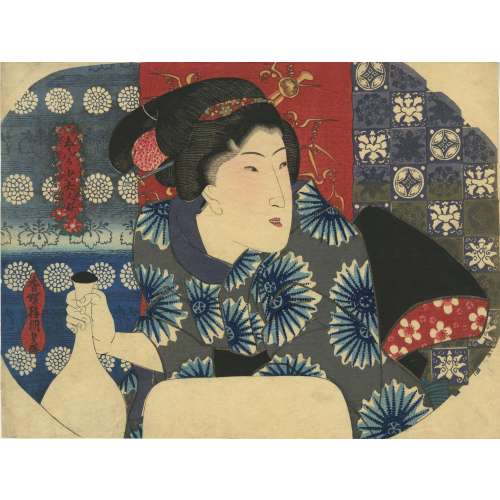 NEWSeries: The taste of the new type of woman (Shingata bijin konomi) [志んかた美人好]. Artist: Utagawa Kunisada [歌川 国貞], a.k.a. Utagawa Toyokuni III [三代 歌川 豊国] (Japanese, 1786 – 1865). Signed: Kōchōrō Kunisada ga [香朝楼國貞画] in a red double-gourd cartouche. No publisher seal. No censor/date seal. Media: Untrimmed fan print (Aiban yoko-e uchiwa-e), 228 x 302 mm.
NEWSeries: The taste of the new type of woman (Shingata bijin konomi) [志んかた美人好]. Artist: Utagawa Kunisada [歌川 国貞], a.k.a. Utagawa Toyokuni III [三代 歌川 豊国] (Japanese, 1786 – 1865). Signed: Kōchōrō Kunisada ga [香朝楼國貞画] in a red double-gourd cartouche. No publisher seal. No censor/date seal. Media: Untrimmed fan print (Aiban yoko-e uchiwa-e), 228 x 302 mm. -
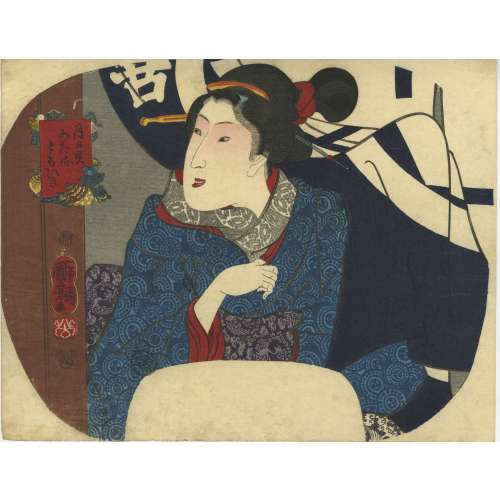 NEWSeries: Moon and sun shells for tomobiki (Tsukihigai ataru tomobiki) [月日貝あたるともびき] – hiragana inscription in the red cartouche. According to Kuniyoshi Project, Tomobiki (友引) is a fortuitous day for conducting business. There are also other meanings of the same notion of 友引. Artist: Utagawa Kuniyoshi [歌川 國芳] (1798 – 1861). Signed: Ichiyûsai Kuniyoshi ga [一勇斎 國芳戯画] (drawn by Ichiyūsai Kuniyoshi) in a red double-gourd cartouche with a kiri-mon seal beneath. Publisher: Ibaya Kyūbei [伊場屋久兵衛] (Japanese, 1804 – 1851); seal [板元,久] – Hanmoto, Kyū; Marks 19-040|126e. Single nanushi censor seal: Mura [村] = Murata Sahei [村田佐右衛] (VI/1842 – V/1846). This series has five more known prints; some have Tanaka [田中] censor seal (I/1844–II/1845). Media: Fan print (uchiwa-e, 団扇絵), 230 x 297 mm.
NEWSeries: Moon and sun shells for tomobiki (Tsukihigai ataru tomobiki) [月日貝あたるともびき] – hiragana inscription in the red cartouche. According to Kuniyoshi Project, Tomobiki (友引) is a fortuitous day for conducting business. There are also other meanings of the same notion of 友引. Artist: Utagawa Kuniyoshi [歌川 國芳] (1798 – 1861). Signed: Ichiyûsai Kuniyoshi ga [一勇斎 國芳戯画] (drawn by Ichiyūsai Kuniyoshi) in a red double-gourd cartouche with a kiri-mon seal beneath. Publisher: Ibaya Kyūbei [伊場屋久兵衛] (Japanese, 1804 – 1851); seal [板元,久] – Hanmoto, Kyū; Marks 19-040|126e. Single nanushi censor seal: Mura [村] = Murata Sahei [村田佐右衛] (VI/1842 – V/1846). This series has five more known prints; some have Tanaka [田中] censor seal (I/1844–II/1845). Media: Fan print (uchiwa-e, 団扇絵), 230 x 297 mm. -
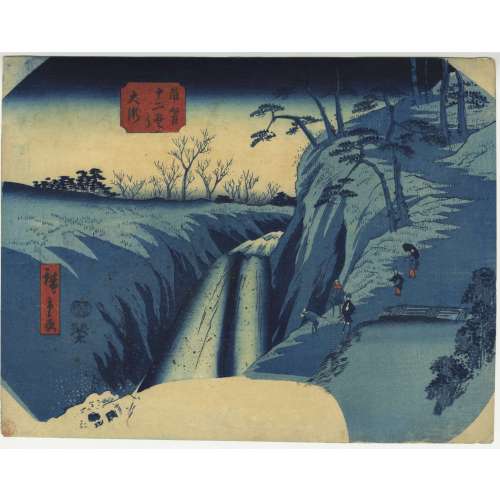 NEWTitle: The Great Waterfall at the Twelve Shrines of Tsunohazu (Tsunohazu juniso otaki) [角筈十二社大滝] from an untitled set of views of famous places in Edo. Artist: Utagawa Hiroshige II [二代目 歌川広重] (Japanese, 1826 – 1869) – a son-in-law of Andō Hiroshige. Signature: Hiroshige ga [廣重画] Dimensions: Aiban yoko-e uchiwa-e, 226 x 291 mm. Combined date/censor seal: tori, 酉 / kiwame 極 – 1861 (Man'en 2 / Bunkyū 1 from 19/II). Publisher: Yama-Ta; seal: [板元, 太] – Hanmoto, Ta; Marks 19-044 | U421b: An unknown publisher in Edo, fl. c. 1815-61. Provenance: Collection of Maroni, Albert (French, 1852 – 1923), red stamp in the bottom-left corner. Reference: [LIB-3429.2025] Christie’s, New York: Japanese Art, Thursday 24 April 1997 / Sales Catalogue; lot № 312.
NEWTitle: The Great Waterfall at the Twelve Shrines of Tsunohazu (Tsunohazu juniso otaki) [角筈十二社大滝] from an untitled set of views of famous places in Edo. Artist: Utagawa Hiroshige II [二代目 歌川広重] (Japanese, 1826 – 1869) – a son-in-law of Andō Hiroshige. Signature: Hiroshige ga [廣重画] Dimensions: Aiban yoko-e uchiwa-e, 226 x 291 mm. Combined date/censor seal: tori, 酉 / kiwame 極 – 1861 (Man'en 2 / Bunkyū 1 from 19/II). Publisher: Yama-Ta; seal: [板元, 太] – Hanmoto, Ta; Marks 19-044 | U421b: An unknown publisher in Edo, fl. c. 1815-61. Provenance: Collection of Maroni, Albert (French, 1852 – 1923), red stamp in the bottom-left corner. Reference: [LIB-3429.2025] Christie’s, New York: Japanese Art, Thursday 24 April 1997 / Sales Catalogue; lot № 312.An aizuri-e (blue print) on a popular topic, many times depicted by Andō Hiroshige and Hiroshige II, including the below print by the latter No. 45, the Twelve Kumano Shrines at Tsunohazu (Tsunohazu Kumano jûnisha), from the series Forty-Eight Famous Views of Edo (Edo meisho yonjûhakkei)「江戸名所四十八景 四十五 角筈熊野十二社」
-
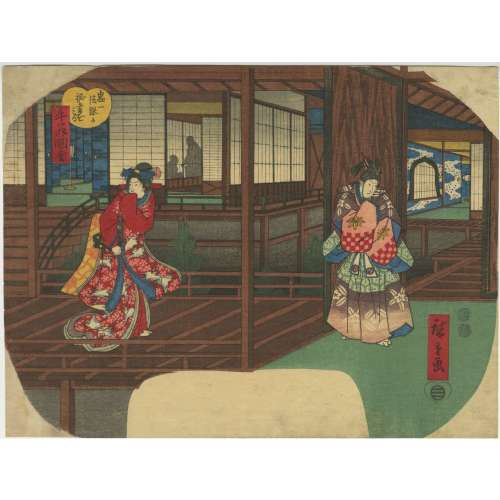 NEWTitle: The Secret Meeting between Ushiwakamaru and the Daughter of Kiichi Hōgen (Kiichi Hōgen ga hisho o miro) [鬼一法眼が秘書をみる] Series: Scenes from the life of Ushiwaka (Ushiwaka zue) [牛若図会] Artist: Utagawa Hiroshige [歌川 広重] a.k.a. Andō Hiroshige [安藤 広重] (Japanese, 1797 – 1858) Signature: Hiroshige ga [廣重画] Dimensions: Aiban yoko-e uchiwa-e, 226 x 303 mm. Censor seal: Hama & Magome [濱 / 馬込]: 1/1849 – 2/1852 (Kaei 2-5) Publisher: Ibaya Senzaburō [伊場屋仙三郎] (Japanese, fl. C. 1845 – 1847), seal: San [三] (Marks 11-001 | 127c). According to Rupert Faulkner (2001), another copy of this fan print is housed at Ōta Memorial Museum (ŌMM 1998, № 258). There are four other known prints from this series: (1) The Meeting at Yahagi: The Beginnings of the Jorurijunidan Story (Yahagi no Shuku Jorurijunidan no Hajime); (2) Ushiwakamaru practising swordsmanship at Sojogatani (ŌMM 1998, no.256); (3) Ushiwakamaru's encounter with Benkei on Gojo Bridge (Matsuki 1924, no.93); and (4) Ise no Saburo swearing an oath of loyalty to Ushiwakamaru (Kanagawa Prefectural Museum of Cultural History). Kiichi Hōgen [鬼一法眼] is a legendary monk and warrior who trained Ushiwakamaru (young Minamoto no Yoshitsune) in swordsmanship, tactics, and magic.Another print (Ushiwakamaru's encounter with Benkei on Gojo Bridge) from this series is in the collection of the Art Institute of Chicago under the title Killing One Thousand People at Gojo Bridge (Gojo no hashi sennin kiri).
NEWTitle: The Secret Meeting between Ushiwakamaru and the Daughter of Kiichi Hōgen (Kiichi Hōgen ga hisho o miro) [鬼一法眼が秘書をみる] Series: Scenes from the life of Ushiwaka (Ushiwaka zue) [牛若図会] Artist: Utagawa Hiroshige [歌川 広重] a.k.a. Andō Hiroshige [安藤 広重] (Japanese, 1797 – 1858) Signature: Hiroshige ga [廣重画] Dimensions: Aiban yoko-e uchiwa-e, 226 x 303 mm. Censor seal: Hama & Magome [濱 / 馬込]: 1/1849 – 2/1852 (Kaei 2-5) Publisher: Ibaya Senzaburō [伊場屋仙三郎] (Japanese, fl. C. 1845 – 1847), seal: San [三] (Marks 11-001 | 127c). According to Rupert Faulkner (2001), another copy of this fan print is housed at Ōta Memorial Museum (ŌMM 1998, № 258). There are four other known prints from this series: (1) The Meeting at Yahagi: The Beginnings of the Jorurijunidan Story (Yahagi no Shuku Jorurijunidan no Hajime); (2) Ushiwakamaru practising swordsmanship at Sojogatani (ŌMM 1998, no.256); (3) Ushiwakamaru's encounter with Benkei on Gojo Bridge (Matsuki 1924, no.93); and (4) Ise no Saburo swearing an oath of loyalty to Ushiwakamaru (Kanagawa Prefectural Museum of Cultural History). Kiichi Hōgen [鬼一法眼] is a legendary monk and warrior who trained Ushiwakamaru (young Minamoto no Yoshitsune) in swordsmanship, tactics, and magic.Another print (Ushiwakamaru's encounter with Benkei on Gojo Bridge) from this series is in the collection of the Art Institute of Chicago under the title Killing One Thousand People at Gojo Bridge (Gojo no hashi sennin kiri).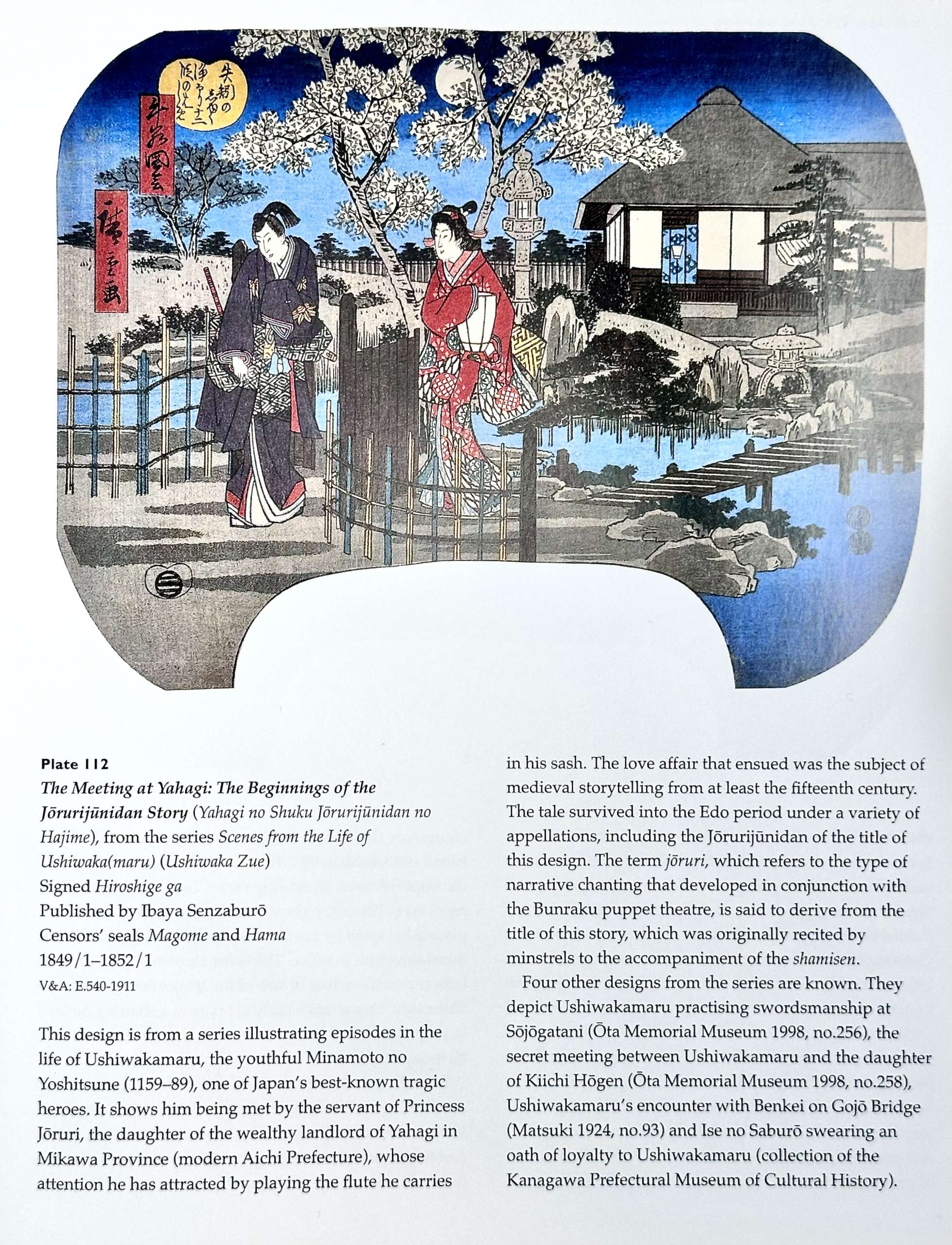
Rupert Faulkner (2001)
Reference: (1) Rupert Faulkner. Hiroshige Fan Prints / Victoria and Albert Museum, Far Eastern Series. — London: V&A Publications; NY: Harry N. Abrams, Inc., 2001. (2) Christophe Marquet. Hiroshige: Les éventails d'Edo / Estampes de la collection Georges Leskowicz. — Paris: In fine, 2022. [Thanks to Horst Graebner].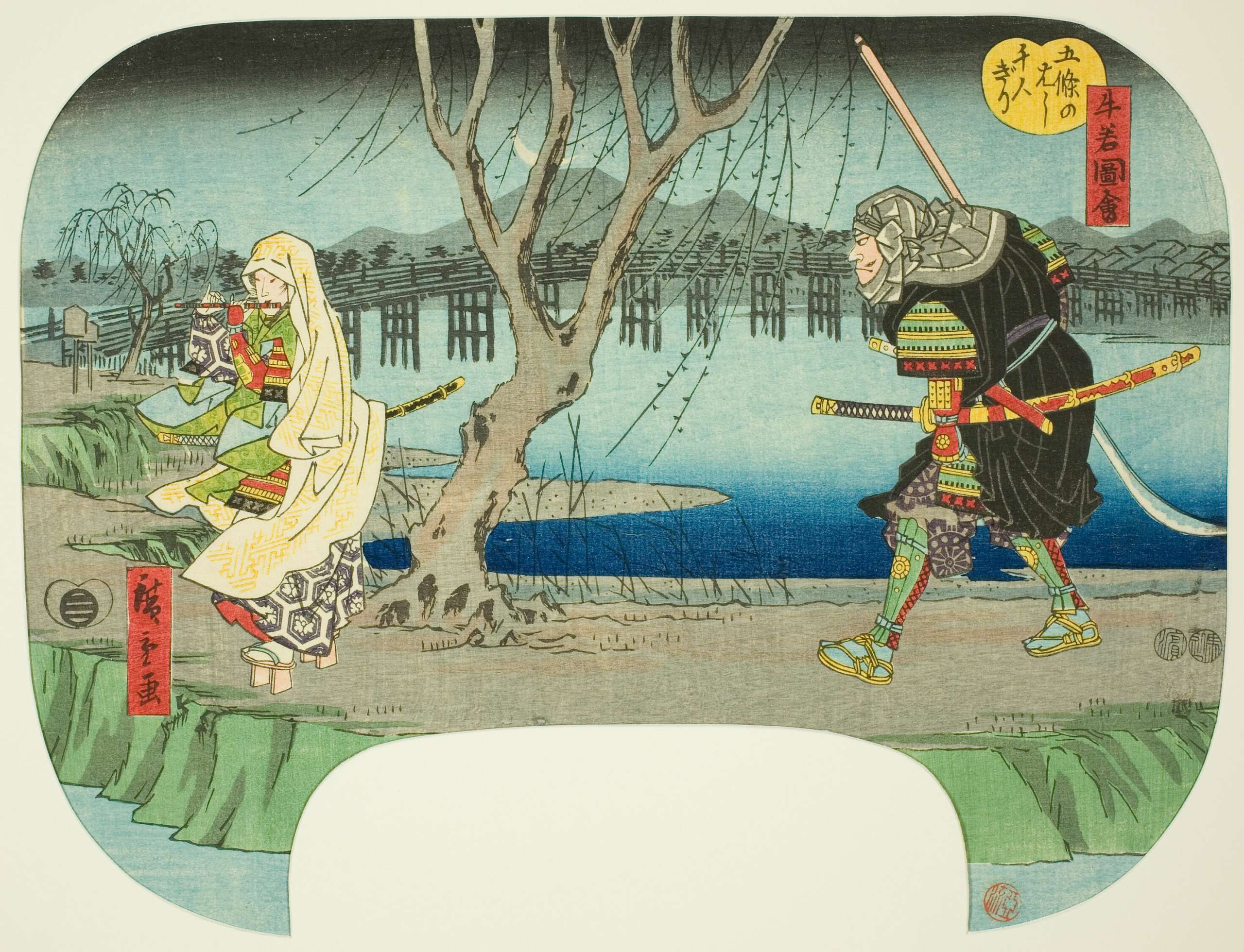
AIC Reference Number 1925.3802
-
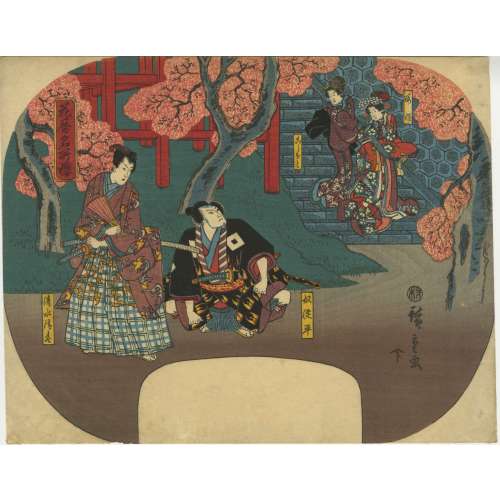 NEWTitle: Flower calendar for the famous cherry blossoms (Hana goyomi meisho sakura) [花暦名所櫻]. A scene from an imaginary (mitate) kabuki play. Names of the characters (left to right): Kiyomizu/Shimizu Seigen [清水清玄]; Yakko (footman) Yodohei [奴淀平]; koshimoto (court lady) [こしもと]; Sakura hime (princess) [桜姫]. The same characters appear in a few real kabuki plays. Artist: Utagawa Hiroshige [歌川 広重] a.k.a. Andō Hiroshige [安藤 広重] (Japanese, 1797 – 1858) Signature: Hiroshige ga [廣重画] Dimensions: Aiban yoko-e uchiwa-e, 232 x 295 mm. Censor seal: "Mura" [村] for Murata Sahei [村田佐兵衛], used from VI/1842 to V/1846 (Tenpō 13 – Kōka 3). Publisher: Enshūya Matabei [遠州屋又兵衛] (Enterprise, active c. 1768 – 1881); seal: "To" (ト) (Marks 01-031 | 057a). [Thanks to Horst Graebner].
NEWTitle: Flower calendar for the famous cherry blossoms (Hana goyomi meisho sakura) [花暦名所櫻]. A scene from an imaginary (mitate) kabuki play. Names of the characters (left to right): Kiyomizu/Shimizu Seigen [清水清玄]; Yakko (footman) Yodohei [奴淀平]; koshimoto (court lady) [こしもと]; Sakura hime (princess) [桜姫]. The same characters appear in a few real kabuki plays. Artist: Utagawa Hiroshige [歌川 広重] a.k.a. Andō Hiroshige [安藤 広重] (Japanese, 1797 – 1858) Signature: Hiroshige ga [廣重画] Dimensions: Aiban yoko-e uchiwa-e, 232 x 295 mm. Censor seal: "Mura" [村] for Murata Sahei [村田佐兵衛], used from VI/1842 to V/1846 (Tenpō 13 – Kōka 3). Publisher: Enshūya Matabei [遠州屋又兵衛] (Enterprise, active c. 1768 – 1881); seal: "To" (ト) (Marks 01-031 | 057a). [Thanks to Horst Graebner]. -
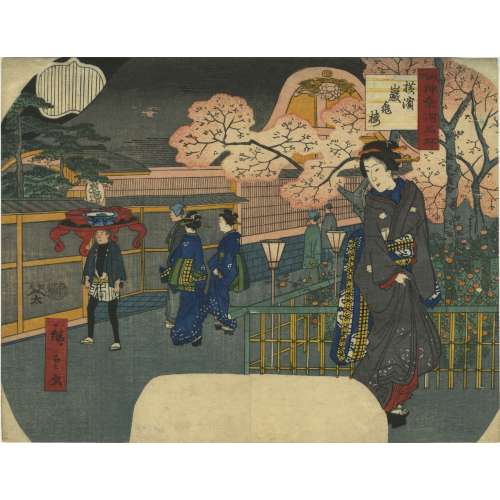 NEWIn red cartouche: Famous places in Bushū and Kanagawa (Bushū Kanagawa meisho) [武州神奈河名昕] In yellow striped square: Gankirō in Yokohama (Yokohama Gankirō) [横濱巌亀楼] / new spelling 横浜岩亀楼. The three kanji [岩亀楼] (Gankirō) are also visible on the sign or lantern above the food tray, carried on the head by a man on the left. Gankirō – the largest 'tea house' (brothel) for foreigners in the Miyozaki pleasure quarters, similar to those in Yoshiwara, in Edo. Artist: Utagawa Hiroshige II [二代目 歌川広重] (Japanese, 1826 – 1869) – a son-in-law of Andō Hiroshige. Signature: Hiroshige ga [廣重画] Dimensions: Aiban yoko-e uchiwa-e, 223 x 289 mm. Combined date/censor seal: monkey (saru - 申) and kiwame (極), 1860. Publisher: Yama-Ta; seal: [板元, 太] – Hanmoto, Ta; Marks 19-044 | U421b: An unknown publisher in Edo, fl. c. 1815-61. Another Hiroshige II's print with the same subject and even the same characters, but in 3rd month, 1859: Entrance to the Gankirō Tea House in the Miyozaki District, Yokohama, Bushu (Bushu Yokohama Gankirō) [諸国名所百景 武州横浜岩亀楼]. Utagawa Yoshikazu's [歌川芳員] depiction of the place in c. 1861 from the inside:[Thanks to Horst Graebner].
NEWIn red cartouche: Famous places in Bushū and Kanagawa (Bushū Kanagawa meisho) [武州神奈河名昕] In yellow striped square: Gankirō in Yokohama (Yokohama Gankirō) [横濱巌亀楼] / new spelling 横浜岩亀楼. The three kanji [岩亀楼] (Gankirō) are also visible on the sign or lantern above the food tray, carried on the head by a man on the left. Gankirō – the largest 'tea house' (brothel) for foreigners in the Miyozaki pleasure quarters, similar to those in Yoshiwara, in Edo. Artist: Utagawa Hiroshige II [二代目 歌川広重] (Japanese, 1826 – 1869) – a son-in-law of Andō Hiroshige. Signature: Hiroshige ga [廣重画] Dimensions: Aiban yoko-e uchiwa-e, 223 x 289 mm. Combined date/censor seal: monkey (saru - 申) and kiwame (極), 1860. Publisher: Yama-Ta; seal: [板元, 太] – Hanmoto, Ta; Marks 19-044 | U421b: An unknown publisher in Edo, fl. c. 1815-61. Another Hiroshige II's print with the same subject and even the same characters, but in 3rd month, 1859: Entrance to the Gankirō Tea House in the Miyozaki District, Yokohama, Bushu (Bushu Yokohama Gankirō) [諸国名所百景 武州横浜岩亀楼]. Utagawa Yoshikazu's [歌川芳員] depiction of the place in c. 1861 from the inside:[Thanks to Horst Graebner].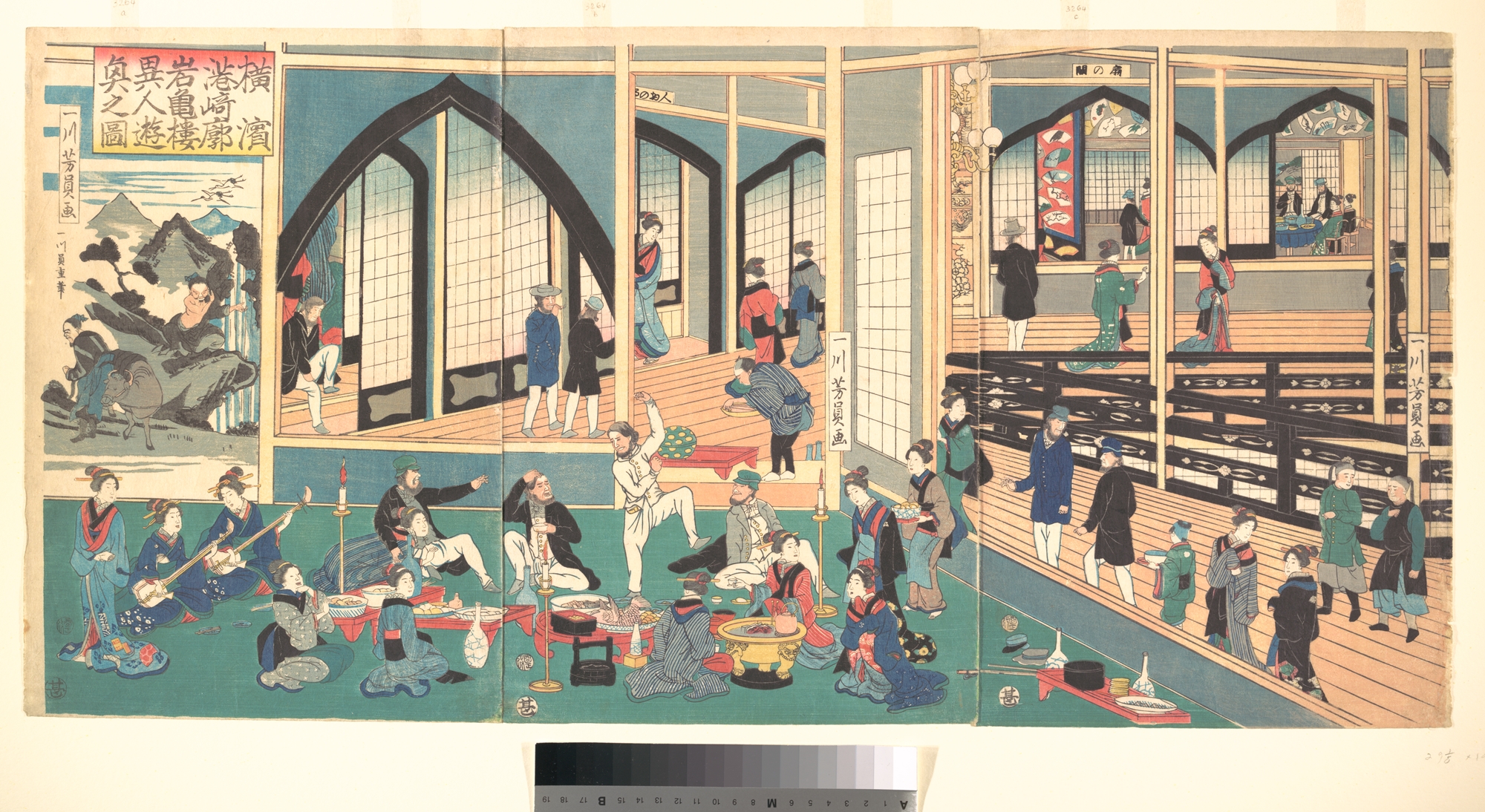
Foreigners Enjoying Themselves in the Gankirō. MET JP3264.
-
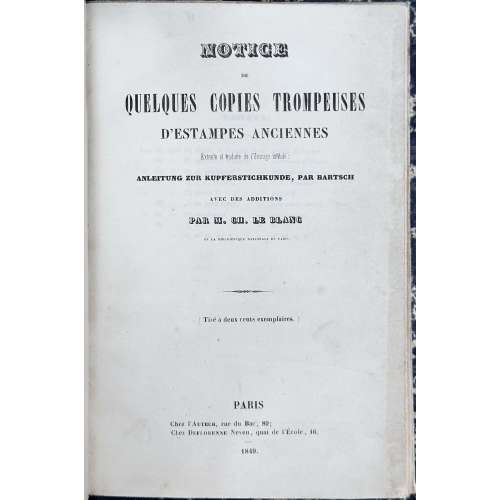 Hardcover, 206 x 138 mm, quarter blue buckram over marbled paper boards, red and green calf labels with gilt lettering to spine; pp.:[2] [1-5] 6-34 (53, i.e. 35), [36], [2]; collated [1]6, 24, 34, 46 i.e. 20 leaves plus 13 leaves of plates. Bookseller ticket to front pastedown A. Aubry libraire, 18 rue Séguier, Paris. Title-page: NOTICE | DE | QUELQUES COPIES TROMPEUSES | D'ESTAMPES ANCIENNES | Extraite et traduite de l'Ouvrage intituled : | ANLEITUNG ZUR KUPFERSTICHKUNDE, PAR BARTSCH | AVEC DES ADDITIONS | PAR M. CH. LE BLANC | DE LA BIBLIOTHÈQUE NATIONALE DE PARIS. | — | ( Tiré à deux cents exemplaires. ) | PARIS | Chez l'AUTEUR, rue du Bac, 89; | Chez DEFLORENNE Neveu, quai de l'École, 16. | 1849. || Author: Charles Le Blanc (French, 1817 – 1865)
Hardcover, 206 x 138 mm, quarter blue buckram over marbled paper boards, red and green calf labels with gilt lettering to spine; pp.:[2] [1-5] 6-34 (53, i.e. 35), [36], [2]; collated [1]6, 24, 34, 46 i.e. 20 leaves plus 13 leaves of plates. Bookseller ticket to front pastedown A. Aubry libraire, 18 rue Séguier, Paris. Title-page: NOTICE | DE | QUELQUES COPIES TROMPEUSES | D'ESTAMPES ANCIENNES | Extraite et traduite de l'Ouvrage intituled : | ANLEITUNG ZUR KUPFERSTICHKUNDE, PAR BARTSCH | AVEC DES ADDITIONS | PAR M. CH. LE BLANC | DE LA BIBLIOTHÈQUE NATIONALE DE PARIS. | — | ( Tiré à deux cents exemplaires. ) | PARIS | Chez l'AUTEUR, rue du Bac, 89; | Chez DEFLORENNE Neveu, quai de l'École, 16. | 1849. || Author: Charles Le Blanc (French, 1817 – 1865) -
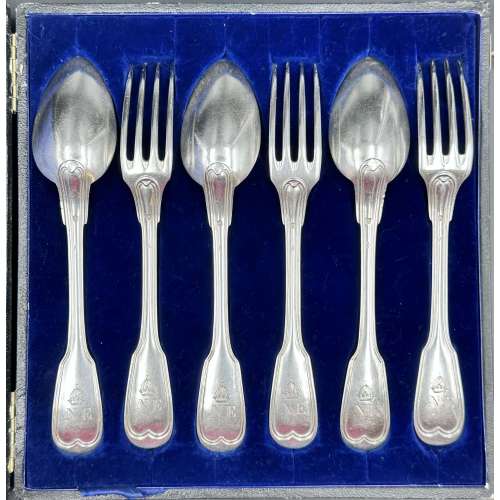 Set of three tablespoons and three forks of fiddle thread pattern with imperial monogram NE under crown to handle in .950 silver by Etienne Henri Sanoner (Paris), with his hallmarks:
Set of three tablespoons and three forks of fiddle thread pattern with imperial monogram NE under crown to handle in .950 silver by Etienne Henri Sanoner (Paris), with his hallmarks:- Minerva’s head with a lock of hair on the temple in an irregular octagonal frame; Paris from 1838 to 1919.
- E (rabbit) S in a diamond of Etienne Henri Sanoner, 79 rue Quincampoix, 75003 Paris.
- Grasshopper (la sauterelle) with chevron
-
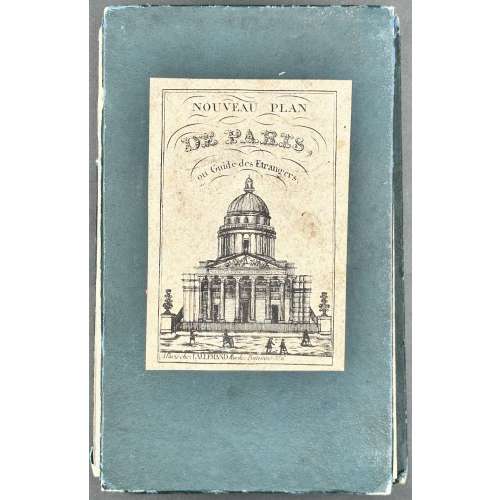 A folding pocket map of Paris, 620 x 890 mm, hand-coloured, folded size: 168 x 102 mm. A high-quality image at Wikimedia Commons. Description by seller: "Contours des arrondissements et mur des fortifications aquarellés. Les arrondissements nouvellement annexés ne sont pas reproduits à l'échelle. Avec indication en bleu des percements haussmaniens en cours. Deux panoramas gravés en marge". Label: NOUVEAU PLAN | DE PARIS, | ou Guide des Étrangers. | {Panthéon} | A Paris chez LALLEMAND Rue de Poitevins No. 6. Title: NOUVEAU PARIS [—] FORTIFIÉ 1860. || PLAN GARANTI~COMPLET | OU | LE GUIDE DAN PARIS | DRESSÉ | PAR LALLEMAND, GÉOGRPHE. GRAV. AU DÉPOT DE LA GUERRE | 1860 | A Paris Rue de Poitevins No. 6. Engraver: Dépôt de la guerre Publisher/Cartographer: Lallemand, Armand Joseph (French, c.1810 – 1871)
A folding pocket map of Paris, 620 x 890 mm, hand-coloured, folded size: 168 x 102 mm. A high-quality image at Wikimedia Commons. Description by seller: "Contours des arrondissements et mur des fortifications aquarellés. Les arrondissements nouvellement annexés ne sont pas reproduits à l'échelle. Avec indication en bleu des percements haussmaniens en cours. Deux panoramas gravés en marge". Label: NOUVEAU PLAN | DE PARIS, | ou Guide des Étrangers. | {Panthéon} | A Paris chez LALLEMAND Rue de Poitevins No. 6. Title: NOUVEAU PARIS [—] FORTIFIÉ 1860. || PLAN GARANTI~COMPLET | OU | LE GUIDE DAN PARIS | DRESSÉ | PAR LALLEMAND, GÉOGRPHE. GRAV. AU DÉPOT DE LA GUERRE | 1860 | A Paris Rue de Poitevins No. 6. Engraver: Dépôt de la guerre Publisher/Cartographer: Lallemand, Armand Joseph (French, c.1810 – 1871) -
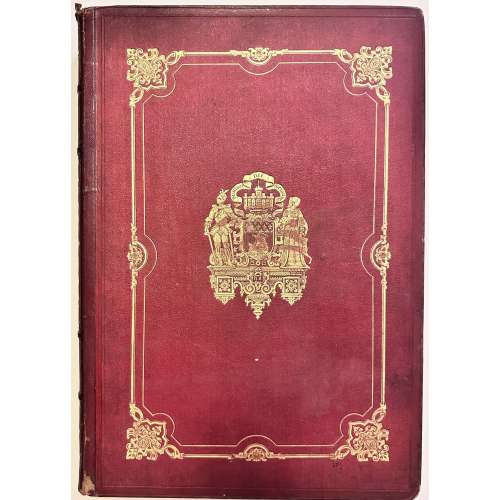 Three volumes, hardcover in-folio, 495 x 350 mm, 1st edition, uniformly bound in red faux-chagrin with gilt coat of arms of the city of Paris in the centre of gild-decorated panel, gilt decorated spine with lettering, marbled endpapers, 3 vol. (122 p.-[46] pl., 76-44-24-22-36-26...); vol. 1 – 340 pp, vol. 2 – 296 pp, vol. 3 – 268 pp ; total 100 leaves of plates. Title-page (red and black): PARIS | DANS SA SPLENDEUR | MONUMENTS, VUES, SCÉNES HISTORIQUES, DESCRIPTIONS ET HISTOIRE | DESSINS ET LITHOGRAPHIES | […] | VIGNETTES DE FÉLIX BENOIST ET CATENACCI, EXÉCUTÉES SUR BOIS PAR LES PREMIERS GRAVURS | TEXTE | […] | Premier Volume (Deuxième Volume, Troisième Volume) | PREMIERE PARTIE. — DESCRIPTION DE PARIS | {vignette} | Publié par | HENRI CHARPENTIER, IMPRIMEUR-ÉDITEUR | PARIS, QUAI DES GRANDS-AUGUSTINS, 55. — ÉTABLESSEMENT A NANTES, RUE DE LA FOSSE. | M. DCCC. LXI. || Contributors: Mérimée, Prosper (French, 1803 – 1870) – text Viollet-le-Duc, Eugène (French, 1814 – 1879) – text Audiganne, Armand (French, 1814 – 1875) – text Philippe Benoist (French, 1813 – 1896) – lithography Benoist, Félix (French, 1818 – 1896) – woodcuts Catenacci, Hercule Louis (French, 1816 – 1884) – woodcuts Charpentier, Henri-Désiré (French, 1806 – 1882) Henri Charpentier imprimeur (Nantes) – printer Henri Charpentier éditeur (Paris) –publisher
Three volumes, hardcover in-folio, 495 x 350 mm, 1st edition, uniformly bound in red faux-chagrin with gilt coat of arms of the city of Paris in the centre of gild-decorated panel, gilt decorated spine with lettering, marbled endpapers, 3 vol. (122 p.-[46] pl., 76-44-24-22-36-26...); vol. 1 – 340 pp, vol. 2 – 296 pp, vol. 3 – 268 pp ; total 100 leaves of plates. Title-page (red and black): PARIS | DANS SA SPLENDEUR | MONUMENTS, VUES, SCÉNES HISTORIQUES, DESCRIPTIONS ET HISTOIRE | DESSINS ET LITHOGRAPHIES | […] | VIGNETTES DE FÉLIX BENOIST ET CATENACCI, EXÉCUTÉES SUR BOIS PAR LES PREMIERS GRAVURS | TEXTE | […] | Premier Volume (Deuxième Volume, Troisième Volume) | PREMIERE PARTIE. — DESCRIPTION DE PARIS | {vignette} | Publié par | HENRI CHARPENTIER, IMPRIMEUR-ÉDITEUR | PARIS, QUAI DES GRANDS-AUGUSTINS, 55. — ÉTABLESSEMENT A NANTES, RUE DE LA FOSSE. | M. DCCC. LXI. || Contributors: Mérimée, Prosper (French, 1803 – 1870) – text Viollet-le-Duc, Eugène (French, 1814 – 1879) – text Audiganne, Armand (French, 1814 – 1875) – text Philippe Benoist (French, 1813 – 1896) – lithography Benoist, Félix (French, 1818 – 1896) – woodcuts Catenacci, Hercule Louis (French, 1816 – 1884) – woodcuts Charpentier, Henri-Désiré (French, 1806 – 1882) Henri Charpentier imprimeur (Nantes) – printer Henri Charpentier éditeur (Paris) –publisher -
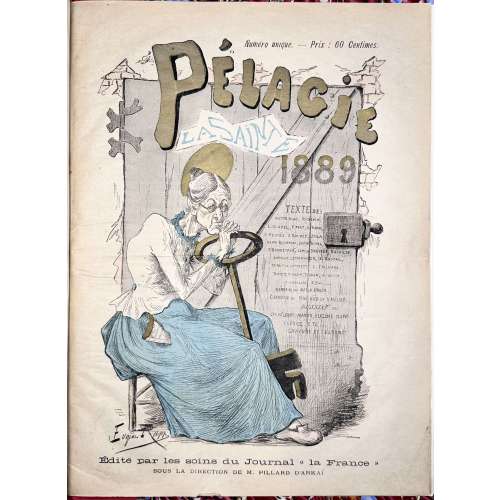 Convolute: Pélagie la sainte. Quarter red buckram over marbled papers with brown gilt-lettered calf label to spine, 399 x 290 mm. Consists of: One blank leaf
Convolute: Pélagie la sainte. Quarter red buckram over marbled papers with brown gilt-lettered calf label to spine, 399 x 290 mm. Consists of: One blank leaf- Gérard de Nerval. Mémoires d'un parisien: Sainte-Pélagie, en. 1832. Published in L'Artiste : journal de la littérature et des beaux-arts 1841 (SER2,T7). L'ARTISTE, | JOURNAL DE LA LITTÉRATURE ET DES BEAUX-ARTS. | 2° Série. – Tome 6 (ms pencil 7 et 8) | {vignette signed M. ALOPHE} | PARIS. | AUX BUREAUX DE L'ARTISTE, RUE DE SEINE-SAINT-GERMAIN, 39 | 1840. (crossed out, ms pencil 1841) || Engraved title, h.t./imprint, t.p., pp. 251-256 (six leaves); p. 252-5:
- Talon / Maison de Sainte-Pélagie November 18, 1822 (One leaf)
- Maxime du Camp. Les prisons de Paris. Published in: Revue de deux mondes, 83, № 3 (1eroctobre 1869), pp. [598]-634 (17 leaves).
- Philibert Audebrand. La Gazette de Sainte-Pélagie. Published in: L'Intermédiaire des chercheurs et curieux, № 518, 10 Dec 1889, p. 711. (Newspaper clip).
- Pélagie la Sainte 1889. Numero unique. Edité par les soins du Journal « la France » | SOUS LA DIRECTION DE M. PILLARD D'ARKAÏ || Title engraved on wood and hand-painted. Texts by Paul Adam, Paul Bonnetain, Simon Boubée, Léon Cladel, Camille Dreyfus, Ch. Gilbert-Martin, Victor Hugo, Camille Lemonnier, Maurice Mac-Nab, Louise Michel, Félix Pyat, Rachilde, Xavier Raspail, Jean Richepin, Henri Rochefort, Laurent Tailhade, Émile Zola, etc. Illustrations by Ch. Clérice, Ch. Gilbert-Martin, Alfred Le Petit, Eugène Rapp. Pp. 1-24 (12 leaves). Gallica: Pélagie la sainte, 1889 / [signé Pillard d'Arkaï]
-
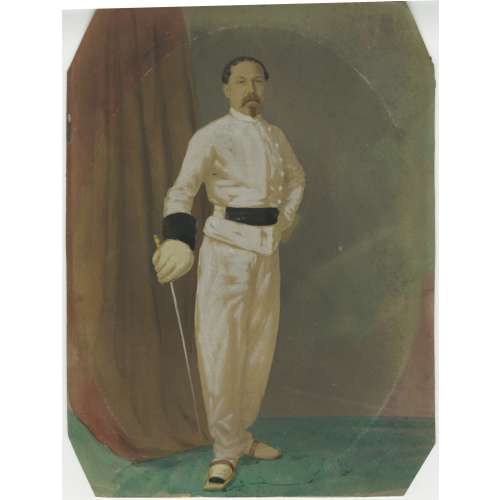 A salt print 208 x 155 mm hand-coloured with watercolours depicting a fencer standing in full gear, mounted on cardboard with all four corners cut out and traces of an oval frame.
A salt print 208 x 155 mm hand-coloured with watercolours depicting a fencer standing in full gear, mounted on cardboard with all four corners cut out and traces of an oval frame. -
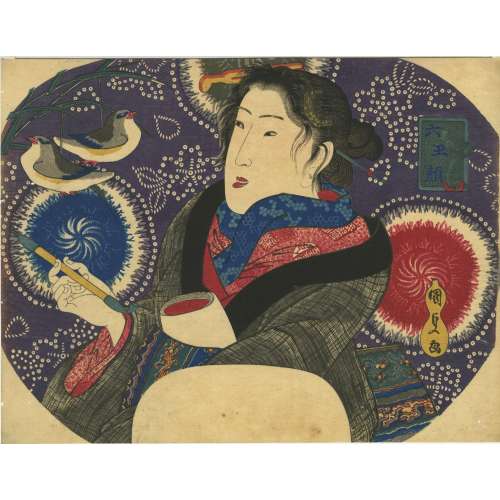 Artist: Utagawa Kunisada [歌川 国貞], a.k.a. Utagawa Toyokuni III [三代 歌川 豊国] (Japanese, 1786 – 1865). Signed: Toyokuni ga [豊国 画] in a yellow double-gourd cartouche. Publisher unknown (privately printed?) Media: Rigid fan print (Aiban Yoko-e Uchiwa-e, 合判横絵 団扇絵), 228 x 298 mm. Series title: Six Jewel Faces (六玉颜, mu tama-gao), a pun on Six Jewel Rivers (六玉河, Mu Tamagawa). The date seal and censor seal are absent. Another print from the same series in the Metropolitan Museum of New York reads:
Artist: Utagawa Kunisada [歌川 国貞], a.k.a. Utagawa Toyokuni III [三代 歌川 豊国] (Japanese, 1786 – 1865). Signed: Toyokuni ga [豊国 画] in a yellow double-gourd cartouche. Publisher unknown (privately printed?) Media: Rigid fan print (Aiban Yoko-e Uchiwa-e, 合判横絵 団扇絵), 228 x 298 mm. Series title: Six Jewel Faces (六玉颜, mu tama-gao), a pun on Six Jewel Rivers (六玉河, Mu Tamagawa). The date seal and censor seal are absent. Another print from the same series in the Metropolitan Museum of New York reads:The colorful background, with explosions of tie-dyed floral motifs, is a reminder of how Kunisada made all his thousands of Genji-print designs a visual record of different textile patterns of the day. The title Six Jewel Faces (Mu tama-gao), along with its allusion to the literary theme of Six Jewel Rivers, suggests that this set of fan prints captures the appearance of a half-dozen attractive individuals, and, indeed, the other five works in the set show images of beautiful women, mostly courtesans of the pleasure quarters.
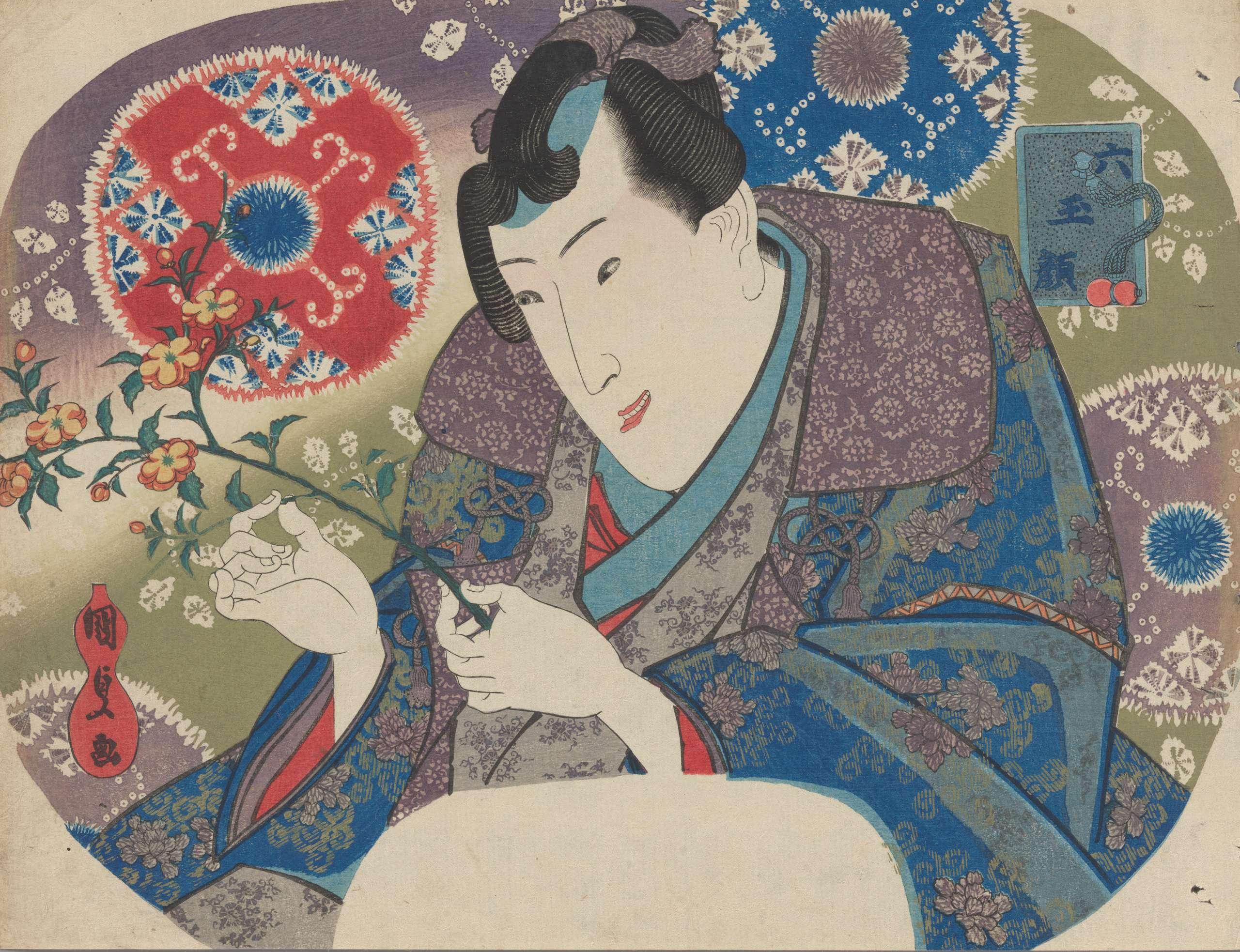 Mitsuuji with Mountain Roses (Yamabuki), from the series “Six Jewel Faces” (Mu tama-gao).
MET Accession Number:2019.3
References:
1) [LIB-2967.2022] Utagawa Kunisada: His world revisited / Catalogue 17, Exhibition March 17-21, 2021. — NY: Sebastian Izzard, LLC., 2021.
2) [LIB-3428.2025] Christie’s, New York: Japanese Prints, Paintings, and Screens, Monday, 24 November 1997 / Sales Catalogue, №№ 84-89.
Description by the latter: "aiban uchiwa-e (22.7 × 29.8 cm.); a beauty against a background of tie-dyed fabric patterns holding a pipe looking at toy birds hanging from bamboo, from the series Mutamagao “Six jewel faces”, the bird decorations alluding to the Jewel River in Noda (Chidori no Tamagawa) in Rikuzen province, signed Kunisada ga".
Mitsuuji with Mountain Roses (Yamabuki), from the series “Six Jewel Faces” (Mu tama-gao).
MET Accession Number:2019.3
References:
1) [LIB-2967.2022] Utagawa Kunisada: His world revisited / Catalogue 17, Exhibition March 17-21, 2021. — NY: Sebastian Izzard, LLC., 2021.
2) [LIB-3428.2025] Christie’s, New York: Japanese Prints, Paintings, and Screens, Monday, 24 November 1997 / Sales Catalogue, №№ 84-89.
Description by the latter: "aiban uchiwa-e (22.7 × 29.8 cm.); a beauty against a background of tie-dyed fabric patterns holding a pipe looking at toy birds hanging from bamboo, from the series Mutamagao “Six jewel faces”, the bird decorations alluding to the Jewel River in Noda (Chidori no Tamagawa) in Rikuzen province, signed Kunisada ga".
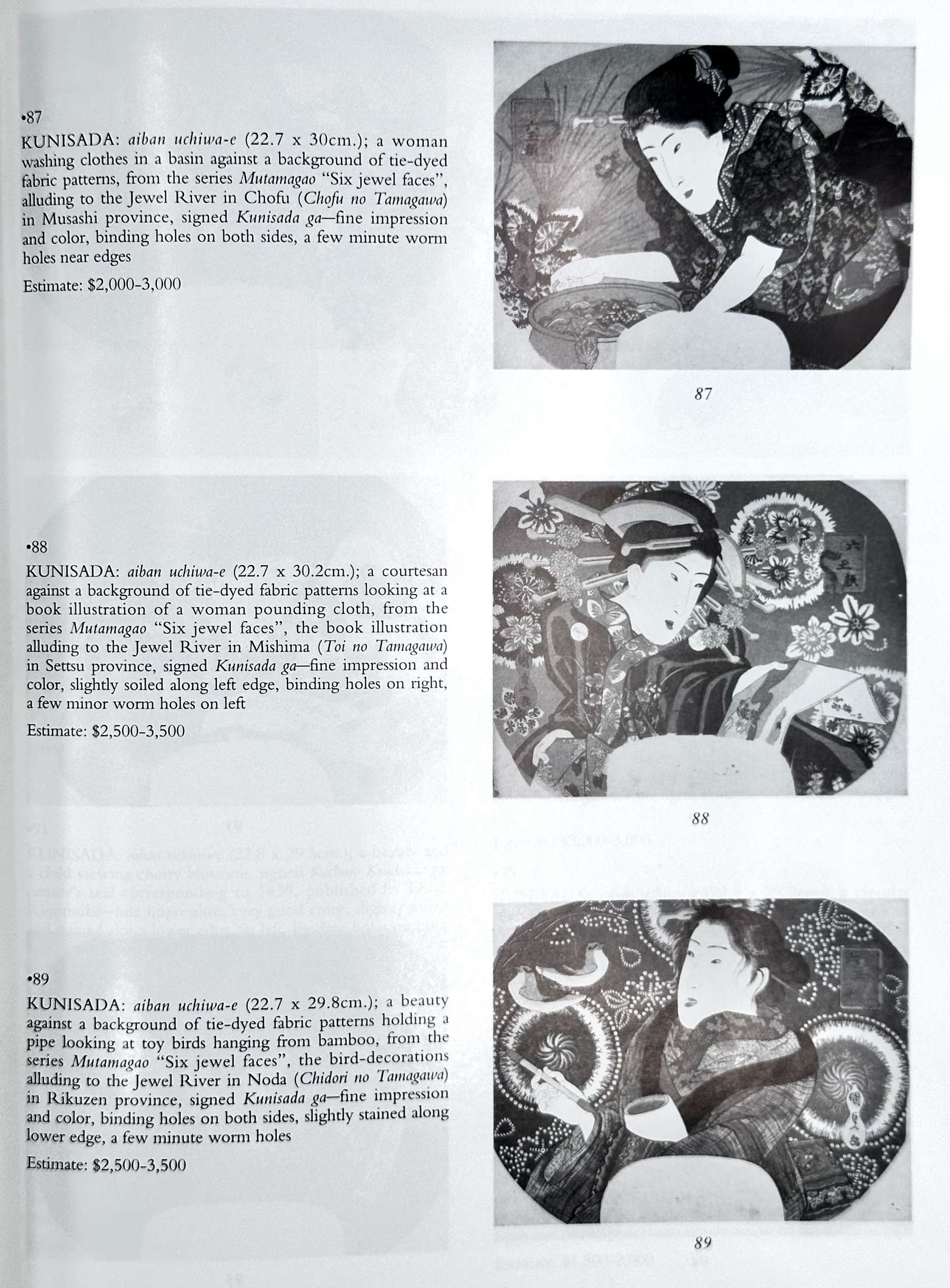

-
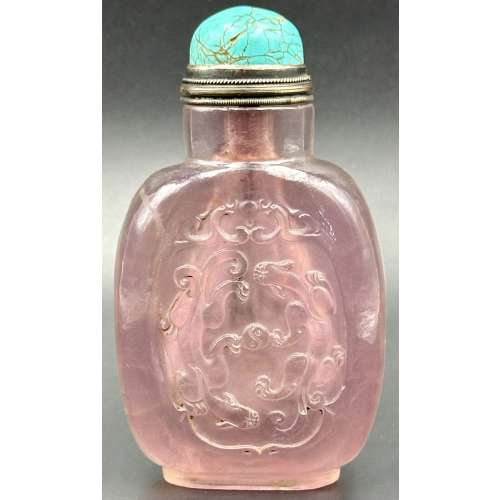 Rose quartz snuff bottle of rounded rectangular form on raised foot with round neck, carved in relief with a double dragon in a cartouche; round turquoise stopper with silver collar.
Rose quartz snuff bottle of rounded rectangular form on raised foot with round neck, carved in relief with a double dragon in a cartouche; round turquoise stopper with silver collar.The Eastern dragon is not the gruesome monster of medieval imagination, but the genius of strength and goodness. He is the spirit of change, therefore of life itself. Hidden in the caverns of inaccessible mountains, or coiled in the unfathomed depth of the sea, he awaits the time when he slowly rouses himself into activity. He unfolds himself in the storm clouds; he washes his mane in the blackness of the seething whirlpools. His claws are in the fork of the lightning, his scales begin to glisten in the bark of rain-swept pine trees. His voice is heard in the hurricane, which, scattering the withered leaves of the forest, a dragon quickens a new spring [C. A. S. Williams. Chinese Symbolism and Art Motifs / 3rd Revised Edition. — Rutland, Vermont & Tokyo, Japan: Charles E. Tuttle Company, 1993].
The Qing dynasty (1644–1911). Mid-19th century. Dimensions: H90 x W52 x D30 mm -
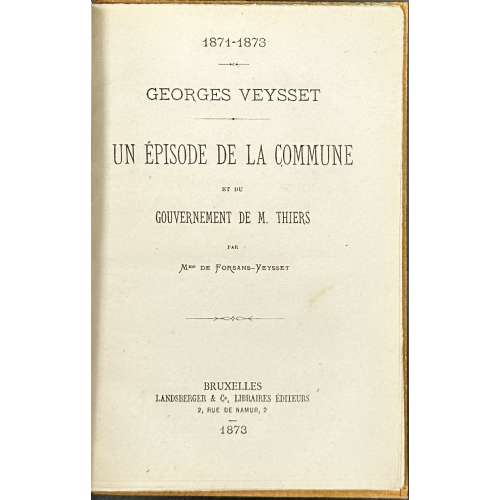 Owner’s hardcover, 182 x 120 mm, yellow buckram, crimson morocco label to spine with gilt lettering; publisher’s pink wrappers preserved, round engraved bookplate to front pastedown “DE LA BIBLIOTHÈQUE DE JULES RICHARD” cut to the border (“Imp. r. C. Motteroz” cut out); Pp.: [4] [1-5] 6-83 [84], various mss and printed clippings, 2 extra ffls to front and back. Title-page: 1871-1873 | — | GORGES VEYSSET | — | UN ÉPISODE DE LA COMMUNE | ET DU | GOUVERNEMENT DE M. THIERS | PAR | Mme DE FORSANS-YEYSSET | — | BRUXELLES | LANDSBERGER & C°, LIBRAIRES ÉDITEURS | 2, RUE DE NAMUR, 2 | 1873 || Provenance: Jules Richard (French, 1848 – 1930). Ref: BNF.
Owner’s hardcover, 182 x 120 mm, yellow buckram, crimson morocco label to spine with gilt lettering; publisher’s pink wrappers preserved, round engraved bookplate to front pastedown “DE LA BIBLIOTHÈQUE DE JULES RICHARD” cut to the border (“Imp. r. C. Motteroz” cut out); Pp.: [4] [1-5] 6-83 [84], various mss and printed clippings, 2 extra ffls to front and back. Title-page: 1871-1873 | — | GORGES VEYSSET | — | UN ÉPISODE DE LA COMMUNE | ET DU | GOUVERNEMENT DE M. THIERS | PAR | Mme DE FORSANS-YEYSSET | — | BRUXELLES | LANDSBERGER & C°, LIBRAIRES ÉDITEURS | 2, RUE DE NAMUR, 2 | 1873 || Provenance: Jules Richard (French, 1848 – 1930). Ref: BNF. -
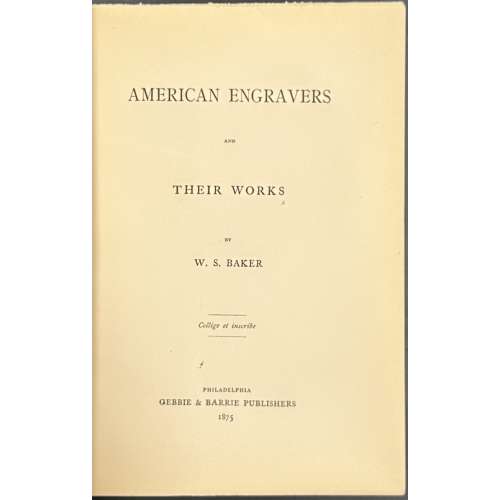 Hardcover, 19 x 13.8 cm, crimson buckram with tan paper label with lettering to spine; printed on laid paper; pp.: ffl [i-vi] vii-x] 11-184, collation 8vo, 1-118 124, total 92 leaves. Title-page: AMERICAN ENGRAVERS | AND | THEIR WORKS | BY | W. S. BAKER | Collige et inscribe | PHILADELPHIA | GEBBIE & BARRIE PUBLISHERS | 1875 || Motto: Collige et inscribe [Collect and record, lat.] Contributors: William Spohn Baker (American, 1824 – 1897) – author. George Gebbie (American, 1832 – 1892) – publisher. George Barrie (American, 1843 – 1918) – publisher. George R. Bonfield (British-American, 1802 – 1898) – dedicatee.
Hardcover, 19 x 13.8 cm, crimson buckram with tan paper label with lettering to spine; printed on laid paper; pp.: ffl [i-vi] vii-x] 11-184, collation 8vo, 1-118 124, total 92 leaves. Title-page: AMERICAN ENGRAVERS | AND | THEIR WORKS | BY | W. S. BAKER | Collige et inscribe | PHILADELPHIA | GEBBIE & BARRIE PUBLISHERS | 1875 || Motto: Collige et inscribe [Collect and record, lat.] Contributors: William Spohn Baker (American, 1824 – 1897) – author. George Gebbie (American, 1832 – 1892) – publisher. George Barrie (American, 1843 – 1918) – publisher. George R. Bonfield (British-American, 1802 – 1898) – dedicatee. -
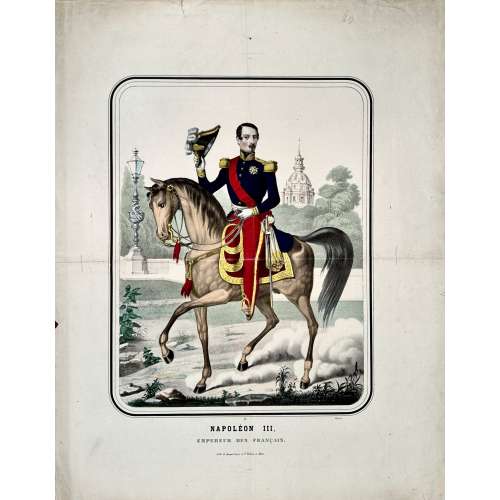 Hand-coloured chromolithography on wove paper, 600 x 470 mm; black ink stamp “4921” to reverse, horizontal and vertical centrefolds. Image of Napoléon III on horseback, in a frame; lettering under the frame: 34 — Déposé | NAPOLÉON III | EMPEREUR DES FRANÇAIS. | Lith. de Gangel frères et P. Didion, à Metz. || Gangel frères et P. Didion (Metz) – printer/publisher. Paulin Didion (French, 1831 – 1879)
Hand-coloured chromolithography on wove paper, 600 x 470 mm; black ink stamp “4921” to reverse, horizontal and vertical centrefolds. Image of Napoléon III on horseback, in a frame; lettering under the frame: 34 — Déposé | NAPOLÉON III | EMPEREUR DES FRANÇAIS. | Lith. de Gangel frères et P. Didion, à Metz. || Gangel frères et P. Didion (Metz) – printer/publisher. Paulin Didion (French, 1831 – 1879) -
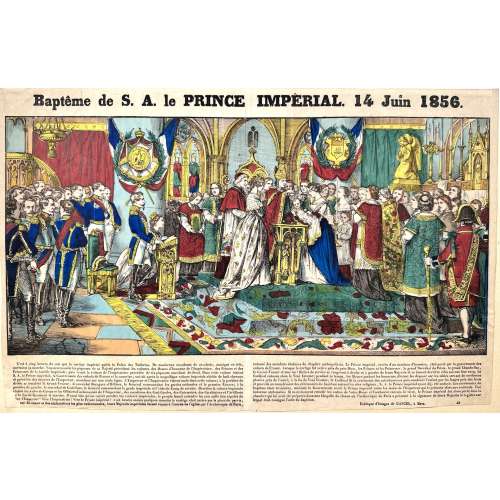 Hand-coloured woodcut on wove paper, 610 x 390 mm; black ink stamp “5207” to reverse, attached to a larger sheet of thick paper with a red ink stamp: “COLLECTION JEAN-CLAUD LACHNITT | REPRODUCTION INTERDIT”. Top: Baptême de S. A. le PRINCE IMPÉRIAL. 14 Juin 1856; image of baptism of Prince-Impérial; two-column text with a small loss in the lower left corner (C'est à cinq heures du soir que le cortège impérial quitta le Palais des Tuileries. De nombreux escadrons de cavalerie, musique en tête ouvraient la marche. ...); bottom under the text: "Fabrique d'Images de GANGEL, à Metz." — "49".
Hand-coloured woodcut on wove paper, 610 x 390 mm; black ink stamp “5207” to reverse, attached to a larger sheet of thick paper with a red ink stamp: “COLLECTION JEAN-CLAUD LACHNITT | REPRODUCTION INTERDIT”. Top: Baptême de S. A. le PRINCE IMPÉRIAL. 14 Juin 1856; image of baptism of Prince-Impérial; two-column text with a small loss in the lower left corner (C'est à cinq heures du soir que le cortège impérial quitta le Palais des Tuileries. De nombreux escadrons de cavalerie, musique en tête ouvraient la marche. ...); bottom under the text: "Fabrique d'Images de GANGEL, à Metz." — "49". -
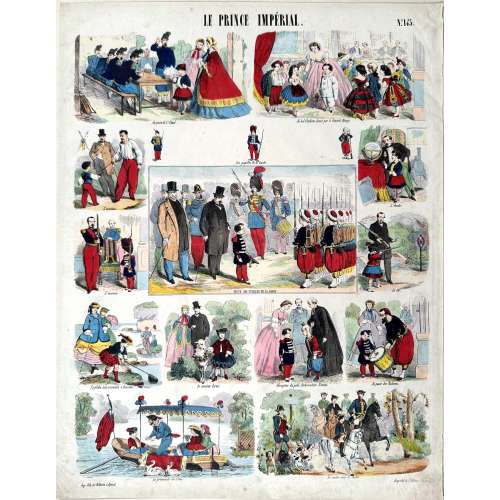 Hand-coloured woodcut on wove paper, 472 x 365 mm; black ink stamp “5275” to reverse. Top centre: "LE PRINCE IMPÉRIAL"; right: "№143." Image in the middle: Prince Impérial, with his father, conducts a review of the children's army "REVUE DES PUPILLES DE LA GARDE". Besides – five tiers of captioned cartoons. Bottom left: "Imp. lith. de Pellerin à Épinal"; right: Propriété de l’Éditeur. Déposé." Jean Charles Pellerin (French, 1756 – 1836) – printer/publisher.
Hand-coloured woodcut on wove paper, 472 x 365 mm; black ink stamp “5275” to reverse. Top centre: "LE PRINCE IMPÉRIAL"; right: "№143." Image in the middle: Prince Impérial, with his father, conducts a review of the children's army "REVUE DES PUPILLES DE LA GARDE". Besides – five tiers of captioned cartoons. Bottom left: "Imp. lith. de Pellerin à Épinal"; right: Propriété de l’Éditeur. Déposé." Jean Charles Pellerin (French, 1756 – 1836) – printer/publisher. -
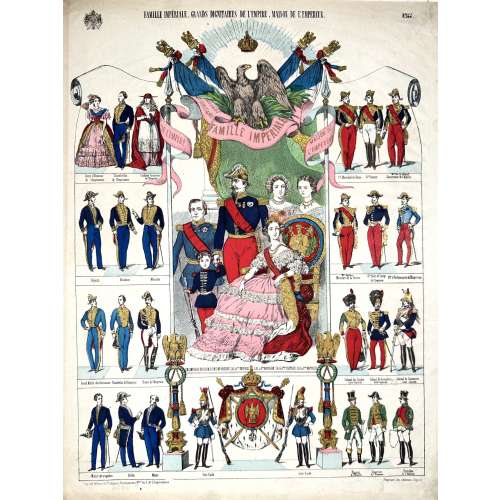 Hand-coloured woodcut on wove paper, 487 x 365 mm; black ink stamp “5056” to reverse. Top left: imperial coat of arms; centre: "FAMILLE IMPERIALE. GRANDS DIGNITAIRES DE L'EMPIRE, MAISON DE L'EMPEREUR."; right: "№144." Image of the imperial family under imperial eagle and standards; besides – four tiers of captioned cartoons. Bottom left: "Imprimerie Lith. de Pellerin, à Épinal"; right: "Propriété de l’Éditeur. — Déposé." Jean Charles Pellerin (French, 1756 – 1836) – printer/publisher.
Hand-coloured woodcut on wove paper, 487 x 365 mm; black ink stamp “5056” to reverse. Top left: imperial coat of arms; centre: "FAMILLE IMPERIALE. GRANDS DIGNITAIRES DE L'EMPIRE, MAISON DE L'EMPEREUR."; right: "№144." Image of the imperial family under imperial eagle and standards; besides – four tiers of captioned cartoons. Bottom left: "Imprimerie Lith. de Pellerin, à Épinal"; right: "Propriété de l’Éditeur. — Déposé." Jean Charles Pellerin (French, 1756 – 1836) – printer/publisher. -
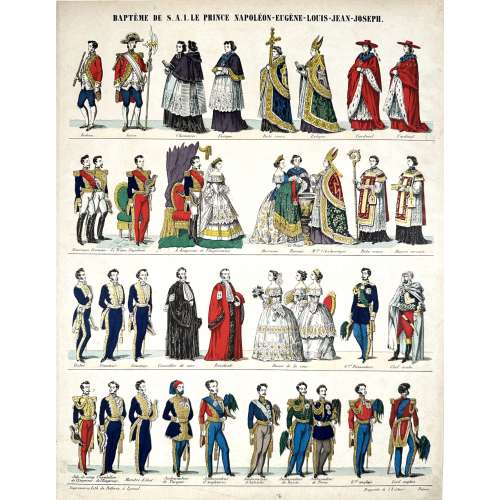 Hand-coloured woodcut on wove paper, 460 x 363 mm; black ink stamp “5054” to reverse. Four tiers with groups of people dressed in uniform, captioned: Bedeau — Suisse — Chanoines — Évêque — Porte croix — Évêque — Cardinal — Cardinal | Généraux français — Le prince Napoléon — L’Empereur et l’Impératrice — Marraine — Le Prince — Parrain | Meur l’Archevêque | Porte crosse Diacre servant | Préfet — Sénateur — Conseiller de cour — Président — Dames de la cour — Gral Piémontais — Chef arabe | Aide-de-camp de l’Empereur — Chambellan de l’Empereur — Ministre d’état — Ambassadeur de Turque | Ambassadeur d’Angleterre — Ambassadeur d’Autriche — Ambassadeur de Russie — Ambassadeur de Prusse — Gral anglaise — Lord anglais || Bottom left: Imprimerie Lith. de Pellerin, à Épinal; right: Propriété de l’Éditeur. — Déposé. Jean Charles Pellerin (French, 1756 – 1836) – printer/publisher.
Hand-coloured woodcut on wove paper, 460 x 363 mm; black ink stamp “5054” to reverse. Four tiers with groups of people dressed in uniform, captioned: Bedeau — Suisse — Chanoines — Évêque — Porte croix — Évêque — Cardinal — Cardinal | Généraux français — Le prince Napoléon — L’Empereur et l’Impératrice — Marraine — Le Prince — Parrain | Meur l’Archevêque | Porte crosse Diacre servant | Préfet — Sénateur — Conseiller de cour — Président — Dames de la cour — Gral Piémontais — Chef arabe | Aide-de-camp de l’Empereur — Chambellan de l’Empereur — Ministre d’état — Ambassadeur de Turque | Ambassadeur d’Angleterre — Ambassadeur d’Autriche — Ambassadeur de Russie — Ambassadeur de Prusse — Gral anglaise — Lord anglais || Bottom left: Imprimerie Lith. de Pellerin, à Épinal; right: Propriété de l’Éditeur. — Déposé. Jean Charles Pellerin (French, 1756 – 1836) – printer/publisher. -
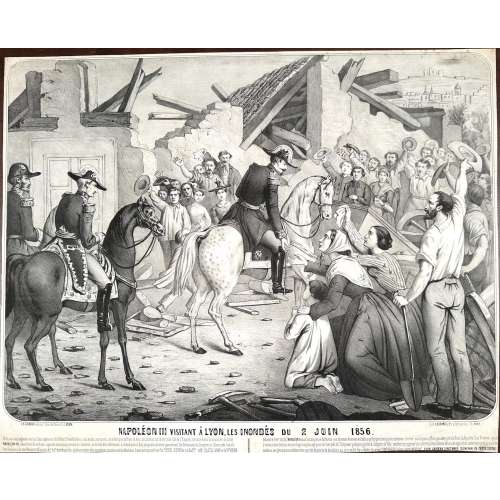 Lithography poster on wove paper, 492 x 614 mm; black ink stamp “5036” to reverse, vertical centerfold. Image in frame; under the frame left: "J. B. Gadola, éditeur. Cours de Brosses 1, à LYON."; right: "Lith LAURANT & Cie r. de Bernardins 34, Paris." Title and text below the image. Jean-Baptiste Gadola (French, 1818 – 1870) – publisher.
Lithography poster on wove paper, 492 x 614 mm; black ink stamp “5036” to reverse, vertical centerfold. Image in frame; under the frame left: "J. B. Gadola, éditeur. Cours de Brosses 1, à LYON."; right: "Lith LAURANT & Cie r. de Bernardins 34, Paris." Title and text below the image. Jean-Baptiste Gadola (French, 1818 – 1870) – publisher. -
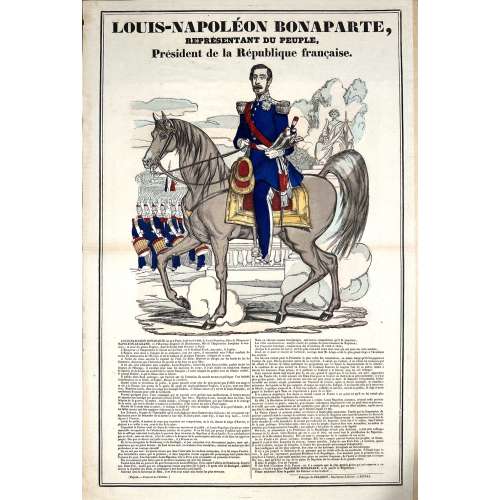 Hand-coloured woodcut poster on wove paper, 622 x 417 mm; black ink stamp “4859” to reverse, horizontal centrefold. In a double frame, top: LOUIS-NAPOLÉON BONAPARTE, | REPRÉSENTANT DU PEUPLE, | Président de la République française. Text under the image ; bottom left: (Déposé.— Propriété de l’Éditeur.); right: Fabrique de PELLERIN, Imprimeur-Libraire, à ÉPINAL. Jean Charles Pellerin (French, 1756 – 1836) – printer/publisher.
Hand-coloured woodcut poster on wove paper, 622 x 417 mm; black ink stamp “4859” to reverse, horizontal centrefold. In a double frame, top: LOUIS-NAPOLÉON BONAPARTE, | REPRÉSENTANT DU PEUPLE, | Président de la République française. Text under the image ; bottom left: (Déposé.— Propriété de l’Éditeur.); right: Fabrique de PELLERIN, Imprimeur-Libraire, à ÉPINAL. Jean Charles Pellerin (French, 1756 – 1836) – printer/publisher. -
 Hand-coloured woodcut on wove paper, 366 x 460 mm; black ink stamp “5057” to reverse. Caption cartoon in 2 tiers. Top: OUVERTURE DE 'EXPOSITION UNIVERSELLE DE 1855. CORTÈGE IMPÉRIAL. Captions top to bottom: Garde de Paris. — Les Cent Gardes. — Cuirassier. — Grenadiers. Middle: Voiture de sa Majesté Napoléon III. | Bottom: Grenadier. — Musique des Guides. — Piqueur de l’Empereur. — Gral Anglais — Généraux — Colonel de Cuirassiers | de la Garde — Généraux. Below left: Imprimerie Lith. de Pellerin, à Épinal; right: Propriété de l’Éditeur. Déposé. Jean Charles Pellerin (French, 1756 – 1836) – printer/publisher.
Hand-coloured woodcut on wove paper, 366 x 460 mm; black ink stamp “5057” to reverse. Caption cartoon in 2 tiers. Top: OUVERTURE DE 'EXPOSITION UNIVERSELLE DE 1855. CORTÈGE IMPÉRIAL. Captions top to bottom: Garde de Paris. — Les Cent Gardes. — Cuirassier. — Grenadiers. Middle: Voiture de sa Majesté Napoléon III. | Bottom: Grenadier. — Musique des Guides. — Piqueur de l’Empereur. — Gral Anglais — Généraux — Colonel de Cuirassiers | de la Garde — Généraux. Below left: Imprimerie Lith. de Pellerin, à Épinal; right: Propriété de l’Éditeur. Déposé. Jean Charles Pellerin (French, 1756 – 1836) – printer/publisher. -
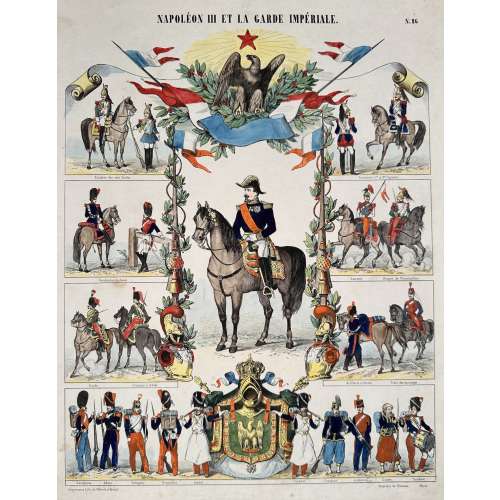 Hand-coloured woodcut on wove paper, 460 x 356 mm; black ink stamp “5055” to reverse. Top centre: "NAPOLÉON III ET LA GARDE IMPÉRIALE"; right: "№ 86". Napoléon III ahorseback in middle, beside (top to bottom): Escadron des cent Gardes — Cuirassiers 1er et 2me regiment; Gendarmes à cheval. — Lancier., Dragon de l’Impératrice.; Guide., Chasseur à cheval. — Artillerie à cheval, Train des équipages.; Gendarme. Génie. Voltigeur. Grenadier. Sapeur. Sapeur. Chasseur. Artillerie. Zouave. Tambour. Bottom left: Imprimerie Lith. de Pellerin à Épinal; right: Propriété de l’Éditeur. Déposé. Jean Charles Pellerin (French, 1756 – 1836) – printer/publisher.
Hand-coloured woodcut on wove paper, 460 x 356 mm; black ink stamp “5055” to reverse. Top centre: "NAPOLÉON III ET LA GARDE IMPÉRIALE"; right: "№ 86". Napoléon III ahorseback in middle, beside (top to bottom): Escadron des cent Gardes — Cuirassiers 1er et 2me regiment; Gendarmes à cheval. — Lancier., Dragon de l’Impératrice.; Guide., Chasseur à cheval. — Artillerie à cheval, Train des équipages.; Gendarme. Génie. Voltigeur. Grenadier. Sapeur. Sapeur. Chasseur. Artillerie. Zouave. Tambour. Bottom left: Imprimerie Lith. de Pellerin à Épinal; right: Propriété de l’Éditeur. Déposé. Jean Charles Pellerin (French, 1756 – 1836) – printer/publisher. -
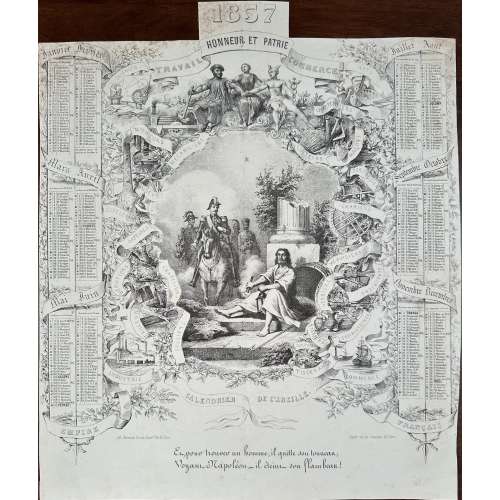 Lithography and etching on wove paper432 x 362 mm, black ink stamp “5022” to reverse, horizontal and vertical centrefolds. Depicts Diogenes (Ancient Greek, 412/404 – 323 BC) beside his barrel and extinguishing his torch when approached by Napoléon III ahorseback. Top: "1857 | HONNEUR ET PATRIE"; lettering on ribbons (top-down): SCIENCES, TRAVAIL, COMMERCE, ARTS, CHARPENTIERS, IMPRIMEURS, "MECHANICIENS, AGRICULTEURS, MAÇONS, FONDEURS, TERRASIERS, CIZELEURS, CARRIERS, ORFEVRES, BIJOUTIERS, CHAPELIERS, MENUISIERS, VERRIERS, SERRURIERS, TAILLEURS, SELLIERS, POTIERS, PORCELAINIERS, CORDONNIERS, TISSERANDS, INDUSTRIE, COMMERCE | CALENDRIER DE L'ABEILLE | EMPIRE, FRANÇAIS. Below left: "lith. Barousse Cour du Comm. 11 et 12. Paris"; right: "Dépôt rue des Cannettes, 20. Paris"; bottom: "Et, pour trouver un homme, il quitte son tonneau, | Voyant Napoléon, – il éteint son flambeau!" [And, to find a man, he leaves his barrel, | Seeing Napoleon, – he extinguishes his torch!]. Six months on the left and six months on the right-hand side of the calendar, surrounding the image.
Lithography and etching on wove paper432 x 362 mm, black ink stamp “5022” to reverse, horizontal and vertical centrefolds. Depicts Diogenes (Ancient Greek, 412/404 – 323 BC) beside his barrel and extinguishing his torch when approached by Napoléon III ahorseback. Top: "1857 | HONNEUR ET PATRIE"; lettering on ribbons (top-down): SCIENCES, TRAVAIL, COMMERCE, ARTS, CHARPENTIERS, IMPRIMEURS, "MECHANICIENS, AGRICULTEURS, MAÇONS, FONDEURS, TERRASIERS, CIZELEURS, CARRIERS, ORFEVRES, BIJOUTIERS, CHAPELIERS, MENUISIERS, VERRIERS, SERRURIERS, TAILLEURS, SELLIERS, POTIERS, PORCELAINIERS, CORDONNIERS, TISSERANDS, INDUSTRIE, COMMERCE | CALENDRIER DE L'ABEILLE | EMPIRE, FRANÇAIS. Below left: "lith. Barousse Cour du Comm. 11 et 12. Paris"; right: "Dépôt rue des Cannettes, 20. Paris"; bottom: "Et, pour trouver un homme, il quitte son tonneau, | Voyant Napoléon, – il éteint son flambeau!" [And, to find a man, he leaves his barrel, | Seeing Napoleon, – he extinguishes his torch!]. Six months on the left and six months on the right-hand side of the calendar, surrounding the image. -
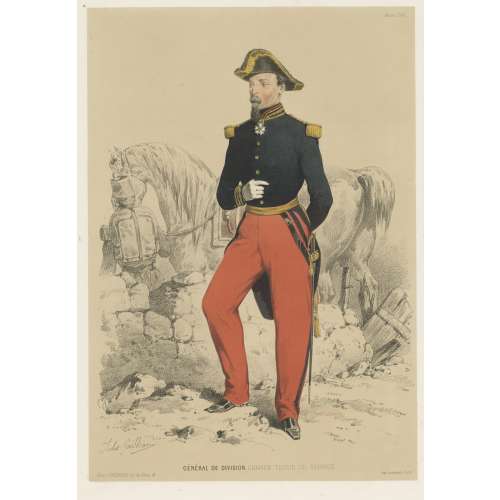 Chromolithography on thick wove paper, 473 x 315 mm sheet, 372 x 260 mm image, black ink stamp “5050” to reverse. Signed on stone "Jules Gaildrau"; below centre: "GÉNERAL DE DIVISION, GRANDE TENUE DE SERVICE"; Bottom left: "Paris, J. Gaildrau, rue de Seine, 16"; right: "Imp. Lemercier, Paris." Joseph Lemercier (French, 1803 – 1887) – printer. Jules Gaildrau (French, 1816 – 1898) – artist.
Chromolithography on thick wove paper, 473 x 315 mm sheet, 372 x 260 mm image, black ink stamp “5050” to reverse. Signed on stone "Jules Gaildrau"; below centre: "GÉNERAL DE DIVISION, GRANDE TENUE DE SERVICE"; Bottom left: "Paris, J. Gaildrau, rue de Seine, 16"; right: "Imp. Lemercier, Paris." Joseph Lemercier (French, 1803 – 1887) – printer. Jules Gaildrau (French, 1816 – 1898) – artist. -
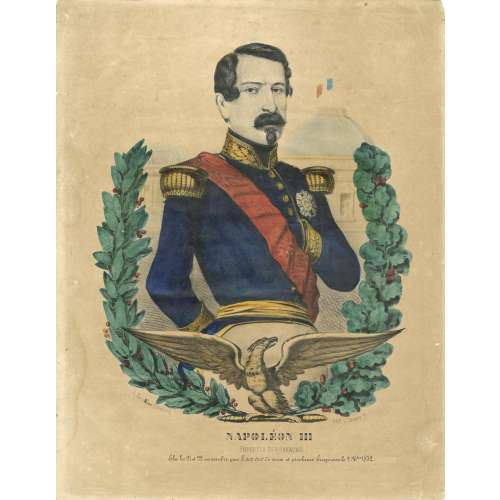 Hand-coloured lithography on wove paper, 380 x 298 mm; black ink stamp “4912” to reverse. On stone left: "A, Paris Miné Éditeur, imp.;" right: "Lith. R. St. Jacques. 41." Bottom center: "Napoléon III"; below: "EMPEREUR DES FRANÇAIS", under: "Élu les 21 el 22 novembre par 8,000,000 de voix et proclamé Empereur le 2 Xbre 1852." Printer/publisher: Miné, éditeur, imprimeur en lithographie, Rue Saint-Jacques, 41. Napoleon III [Charles-Louis Napoléon Bonaparte] (French, 1808 – 1873)
Hand-coloured lithography on wove paper, 380 x 298 mm; black ink stamp “4912” to reverse. On stone left: "A, Paris Miné Éditeur, imp.;" right: "Lith. R. St. Jacques. 41." Bottom center: "Napoléon III"; below: "EMPEREUR DES FRANÇAIS", under: "Élu les 21 el 22 novembre par 8,000,000 de voix et proclamé Empereur le 2 Xbre 1852." Printer/publisher: Miné, éditeur, imprimeur en lithographie, Rue Saint-Jacques, 41. Napoleon III [Charles-Louis Napoléon Bonaparte] (French, 1808 – 1873) -
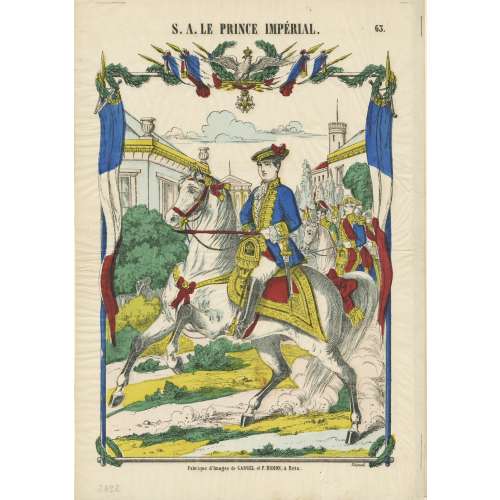 Hand-coloured woodcut on wove paper, 327 x 280 mm; black ink stamp “5265” to reverse, attached to the sheet 470 x 325 mm. Top centre: "S. A. LE PRINCE IMPÉRIAL.", right: "63." Image: equestiral portrait of Prince Impérial. Under the image, centre: "Fabrique d'Images de GANGEL et P. DIDION, à Metz." — "Déposé." Napoléon, Prince Imperial (Napoléon Eugène Louis Jean Joseph Bonaparte] (French, 1856 – 1879). Gangel et P. Didion (Metz); Paulin Didion (French, 1831 – 1879) – publisher/printer.
Hand-coloured woodcut on wove paper, 327 x 280 mm; black ink stamp “5265” to reverse, attached to the sheet 470 x 325 mm. Top centre: "S. A. LE PRINCE IMPÉRIAL.", right: "63." Image: equestiral portrait of Prince Impérial. Under the image, centre: "Fabrique d'Images de GANGEL et P. DIDION, à Metz." — "Déposé." Napoléon, Prince Imperial (Napoléon Eugène Louis Jean Joseph Bonaparte] (French, 1856 – 1879). Gangel et P. Didion (Metz); Paulin Didion (French, 1831 – 1879) – publisher/printer. -
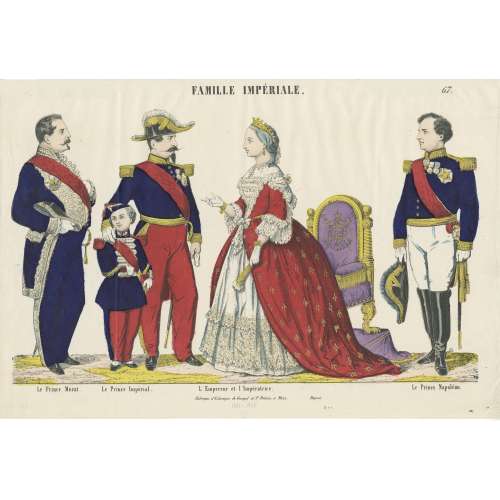 Hand-coloured woodcut on wove paper, 288 x 426 mm; black ink stamp “5305” to reverse. Top centre: "FAMILLE IMPÉRIALE", right: "67." Under the image: "Le Prince Murat." — "Le Prince Impérial." — "L' Empereur et l'Impératrice." — "Le Prince Napoléon." Bottom: "Fabrique d'Estampes de Gangel et P. Didion, à Metz." — "Déposé." Bottom: ms in pencil "1861 – 1868". Publisher/printer: Gangel et P. Didion (Metz); Paulin Didion (French, 1831 – 1879). Characters: Napoleon III [Charles-Louis Napoléon Bonaparte] (French, 1808 – 1873) Eugénie de Montijo [L'impératrice Eugénie] (Spanish-French, 1826 – 1920) Napoléon, Prince Imperial (Napoléon Eugène Louis Jean Joseph Bonaparte] (French, 1856 – 1879) Prince Murat [Lucien Charles Joseph Napoléon] (French, 1803 – 1878) Napoléon-Jérôme Bonaparte [Prince Napoléon] (French, 1822 – 1891)
Hand-coloured woodcut on wove paper, 288 x 426 mm; black ink stamp “5305” to reverse. Top centre: "FAMILLE IMPÉRIALE", right: "67." Under the image: "Le Prince Murat." — "Le Prince Impérial." — "L' Empereur et l'Impératrice." — "Le Prince Napoléon." Bottom: "Fabrique d'Estampes de Gangel et P. Didion, à Metz." — "Déposé." Bottom: ms in pencil "1861 – 1868". Publisher/printer: Gangel et P. Didion (Metz); Paulin Didion (French, 1831 – 1879). Characters: Napoleon III [Charles-Louis Napoléon Bonaparte] (French, 1808 – 1873) Eugénie de Montijo [L'impératrice Eugénie] (Spanish-French, 1826 – 1920) Napoléon, Prince Imperial (Napoléon Eugène Louis Jean Joseph Bonaparte] (French, 1856 – 1879) Prince Murat [Lucien Charles Joseph Napoléon] (French, 1803 – 1878) Napoléon-Jérôme Bonaparte [Prince Napoléon] (French, 1822 – 1891) -
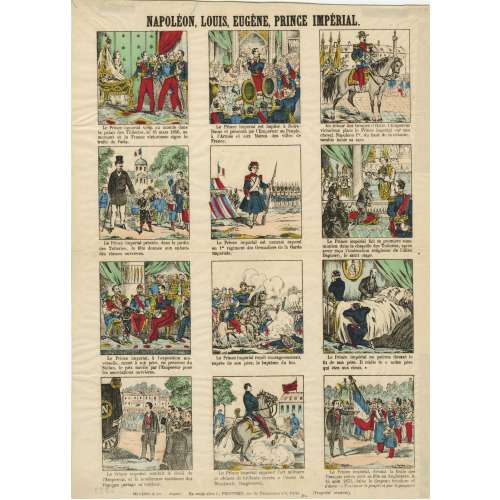 Another copy of SVFC-0745-3.2023, 395 x 290 mm; black ink stamp “5322” to reverse. Jean Charles Pellerin (French, 1756 – 1836)
Another copy of SVFC-0745-3.2023, 395 x 290 mm; black ink stamp “5322” to reverse. Jean Charles Pellerin (French, 1756 – 1836) -
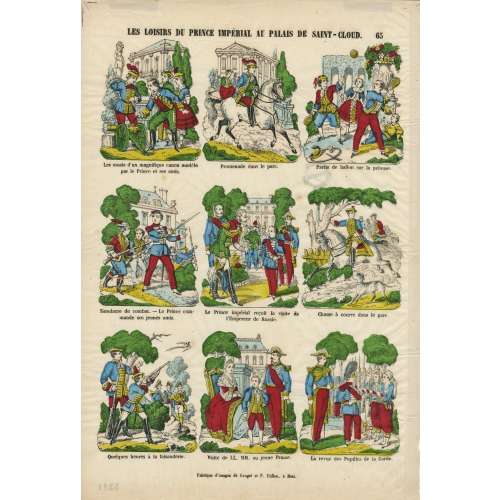 Hand-coloured woodcut on wove paper, 400 x 280 mm; black ink stamp “5321” to reverse. Top: "LES LOISIRS DU PRINCE IMPERIAL AU PALAIS DE SAINT- CLOUD" — "65". Below: nine cartoons with captions.
Hand-coloured woodcut on wove paper, 400 x 280 mm; black ink stamp “5321” to reverse. Top: "LES LOISIRS DU PRINCE IMPERIAL AU PALAIS DE SAINT- CLOUD" — "65". Below: nine cartoons with captions.- Les essais d'un magnifique canon modèle par le Prince et ses amis.
- Promenade dans le parc.
- Partie de ballon sur la pelouse.
- Simulacre de combat. — Le Prince commande ses jeunes amis.
- le Prince impérial reçoit la visite de l'Empereur de Russie.
- Chasse à courre dans le parc.
- Quelques heures à la faisanderie.
- Visite de LL. MM. au jeune Prince.
- La revue des Pupilles de la Garde.
-
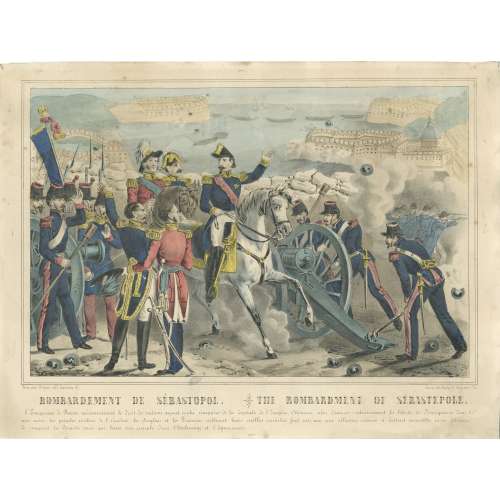 Hand-coloured lithography on wove paper, 250 x 332 mm; black ink stamp “5035” to reverse. Under the frame left: "Paris, chez Riboni, éd. r. Galande, 51"; right: "Paris, lith. Bulla, Pl. Maubert, 26". Below: "BOMBARDEMENT DE SEBASTOPOL. — THE BOMBARDMENT OF SÉBASTOPOLE". Text to bottom. Printers/publishers: Antoine Bulla (fl. 1815 – 1877), François Bulla (fl. c. 1814 – 1855).
Hand-coloured lithography on wove paper, 250 x 332 mm; black ink stamp “5035” to reverse. Under the frame left: "Paris, chez Riboni, éd. r. Galande, 51"; right: "Paris, lith. Bulla, Pl. Maubert, 26". Below: "BOMBARDEMENT DE SEBASTOPOL. — THE BOMBARDMENT OF SÉBASTOPOLE". Text to bottom. Printers/publishers: Antoine Bulla (fl. 1815 – 1877), François Bulla (fl. c. 1814 – 1855). -
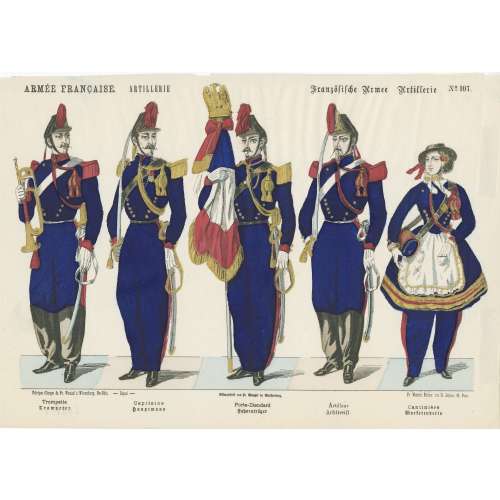 Hand-coloured woodcut on wove paper, 265 x 378 mm; black ink stamp “5051 1” to reverse. Top left: "ARMÉE FRANCAISE. ARTILLERIE"; right: (gothic font) "Französische Armee Artillerie" — "№ 107". Below left: "Fabrique d’Images de Fr. Wentzel à Wissembeurg. Bas-Rhin." — "Déposé" —, centre: "Bilderfabrit von Fr. Wentzel in Weissenburg", right: "Fr. Wentzel, Éditeur, rue St. Jacques, 65, Paris". Bottom: "Trompette | Trompeter" — "Capitaine | Gauptmann" — "Porte-Étendard | Fahnenträger" — "Artilleur | Artillerist" — "Cantinière | Marketenderin". Jean Frédéric Wentzel (French, 1807 – 1869) – publisher/printer.
Hand-coloured woodcut on wove paper, 265 x 378 mm; black ink stamp “5051 1” to reverse. Top left: "ARMÉE FRANCAISE. ARTILLERIE"; right: (gothic font) "Französische Armee Artillerie" — "№ 107". Below left: "Fabrique d’Images de Fr. Wentzel à Wissembeurg. Bas-Rhin." — "Déposé" —, centre: "Bilderfabrit von Fr. Wentzel in Weissenburg", right: "Fr. Wentzel, Éditeur, rue St. Jacques, 65, Paris". Bottom: "Trompette | Trompeter" — "Capitaine | Gauptmann" — "Porte-Étendard | Fahnenträger" — "Artilleur | Artillerist" — "Cantinière | Marketenderin". Jean Frédéric Wentzel (French, 1807 – 1869) – publisher/printer. -
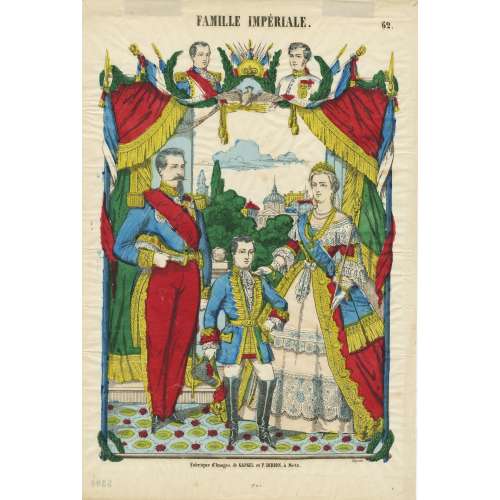 Hand-coloured woodcut on wove paper, 400 x 270 mm; black ink stamp “5306” to reverse. Top centre: "FAMILLE IMPÉRIALE", right: "62."; below centre: "Fabrique d'Images de GANGEL et P. DIDION, à Metz."; right: "Déposé." Publisher/printer: Gangel et P. Didion (Metz); Paulin Didion (French, 1831 – 1879). Characters: Napoleon III [Charles-Louis Napoléon Bonaparte] (French, 1808 – 1873) Eugénie de Montijo [L'impératrice Eugénie] (Spanish-French, 1826 – 1920) Napoléon, Prince Imperial (Napoléon Eugène Louis Jean Joseph Bonaparte] (French, 1856 – 1879) Napoléon II [Napoléon François Joseph Charles Bonaparte] (French, 1811 – 1832) Napoléon Ier [Napoléon Bonaparte] (French, 1769 – 1821)
Hand-coloured woodcut on wove paper, 400 x 270 mm; black ink stamp “5306” to reverse. Top centre: "FAMILLE IMPÉRIALE", right: "62."; below centre: "Fabrique d'Images de GANGEL et P. DIDION, à Metz."; right: "Déposé." Publisher/printer: Gangel et P. Didion (Metz); Paulin Didion (French, 1831 – 1879). Characters: Napoleon III [Charles-Louis Napoléon Bonaparte] (French, 1808 – 1873) Eugénie de Montijo [L'impératrice Eugénie] (Spanish-French, 1826 – 1920) Napoléon, Prince Imperial (Napoléon Eugène Louis Jean Joseph Bonaparte] (French, 1856 – 1879) Napoléon II [Napoléon François Joseph Charles Bonaparte] (French, 1811 – 1832) Napoléon Ier [Napoléon Bonaparte] (French, 1769 – 1821) -
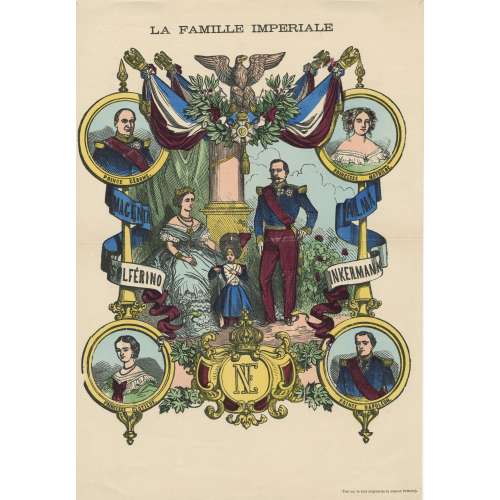 Hand-coloured woodcut on laid paper, 422 x 294 mm; black ink stamp “5307” to reverse, centrefold. Top center: "LA FAMILLE IMPERIALE"; Bottom right: "(Tire sur le bois original de maison Pellerin)". Image: Napoléon III, Empress Eugenie, and Prince Imperial Louis-Napoléon as a child surrounded with four lettered medallions: “PRINCE GÉROME”, “PRINCESSE MATHILDE”, “PRINCESSE CLOTILDE”, and “PRINCE NAPOLÉON”; ribbons lettered: “MAGENTA”, SOLFERINO”, “ALMA”, and “INKERMANN” around heraldic spears; coat of arms with imperial monogram between Princesse Clotilde and Prince Napoléon. Publisher/printer: Jean Charles Pellerin (French, 1756 – 1836). Battle of Magenta : 4 June 1859, against the Austrians. Battle of Solferino : 24 June 1859, against the Austrians. Battle of the Alma : 20 September 1854 (Crimean War) Battle of Inkerman : 5 November 1854 (Crimean War) Characters: Napoleon III [Charles-Louis Napoléon Bonaparte] (French, 1808 – 1873) Eugénie de Montijo [L'impératrice Eugénie] (Spanish-French, 1826 – 1920) Napoléon, Prince Imperial (Napoléon Eugène Louis Jean Joseph Bonaparte] (French, 1856 – 1879) Napoléon-Jérôme Bonaparte [Prince Jérôme] (French, 1822 – 1891) Mathilde Bonaparte [Princess Mathilde] (French, 1820 – 1904) Marie-Clotilde de Savoie [Princesse Clotilde] (French, 1843 – 1911)
Hand-coloured woodcut on laid paper, 422 x 294 mm; black ink stamp “5307” to reverse, centrefold. Top center: "LA FAMILLE IMPERIALE"; Bottom right: "(Tire sur le bois original de maison Pellerin)". Image: Napoléon III, Empress Eugenie, and Prince Imperial Louis-Napoléon as a child surrounded with four lettered medallions: “PRINCE GÉROME”, “PRINCESSE MATHILDE”, “PRINCESSE CLOTILDE”, and “PRINCE NAPOLÉON”; ribbons lettered: “MAGENTA”, SOLFERINO”, “ALMA”, and “INKERMANN” around heraldic spears; coat of arms with imperial monogram between Princesse Clotilde and Prince Napoléon. Publisher/printer: Jean Charles Pellerin (French, 1756 – 1836). Battle of Magenta : 4 June 1859, against the Austrians. Battle of Solferino : 24 June 1859, against the Austrians. Battle of the Alma : 20 September 1854 (Crimean War) Battle of Inkerman : 5 November 1854 (Crimean War) Characters: Napoleon III [Charles-Louis Napoléon Bonaparte] (French, 1808 – 1873) Eugénie de Montijo [L'impératrice Eugénie] (Spanish-French, 1826 – 1920) Napoléon, Prince Imperial (Napoléon Eugène Louis Jean Joseph Bonaparte] (French, 1856 – 1879) Napoléon-Jérôme Bonaparte [Prince Jérôme] (French, 1822 – 1891) Mathilde Bonaparte [Princess Mathilde] (French, 1820 – 1904) Marie-Clotilde de Savoie [Princesse Clotilde] (French, 1843 – 1911) -
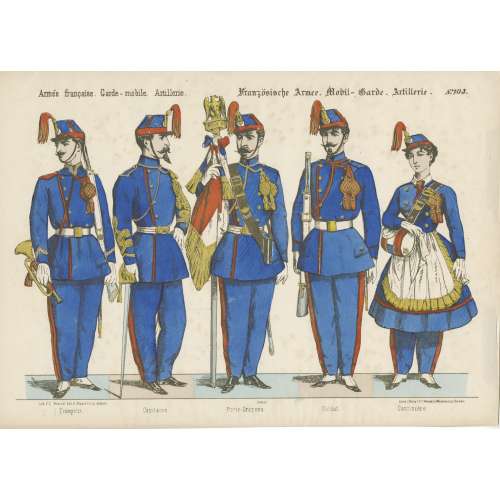 Hand-coloured woodcut on wove paper, 282 x 392 mm; black ink stamp “5051 2” to reverse. Top: "Armée française. Garde–mobile. Artillerie." — (gothic font) "Französische Armee. Mobil–Garde. Artillerie." — "№103". Below left: "Lith F. C. Wentzel édit. à Wissembourg. (Alsacé); center: Déposé; right: Druck u. Verlag v. F. C. Wentzel in Weissemburg. (Elsass)."; Bottom: "Trompette" — "Capitaine" — "Porte-Drapeau". — "Soldat" — "Cantinière." Jean Frédéric Wentzel (French, 1807 – 1869) – publisher/printer.
Hand-coloured woodcut on wove paper, 282 x 392 mm; black ink stamp “5051 2” to reverse. Top: "Armée française. Garde–mobile. Artillerie." — (gothic font) "Französische Armee. Mobil–Garde. Artillerie." — "№103". Below left: "Lith F. C. Wentzel édit. à Wissembourg. (Alsacé); center: Déposé; right: Druck u. Verlag v. F. C. Wentzel in Weissemburg. (Elsass)."; Bottom: "Trompette" — "Capitaine" — "Porte-Drapeau". — "Soldat" — "Cantinière." Jean Frédéric Wentzel (French, 1807 – 1869) – publisher/printer. -
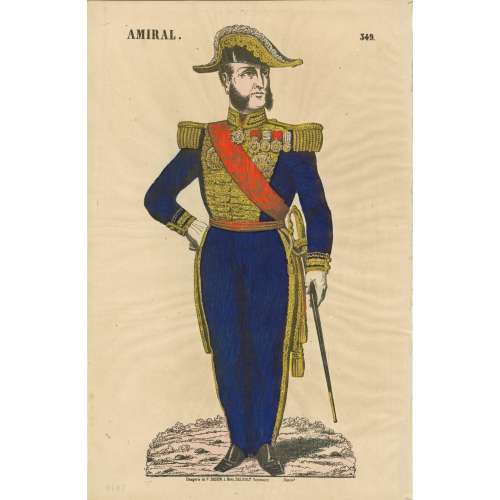 Hand-coloured woodcut on wove paper, 440 x 285 mm; black ink stamp “5049” to reverse. Top left: "AMIRAL"; right: "349". Below: "Imagerie de DIDION, à Metz, DELHALT Successeur." — "Déposé." Paulin Didion (French, 1831 – 1879) – publisher/printer.
Hand-coloured woodcut on wove paper, 440 x 285 mm; black ink stamp “5049” to reverse. Top left: "AMIRAL"; right: "349". Below: "Imagerie de DIDION, à Metz, DELHALT Successeur." — "Déposé." Paulin Didion (French, 1831 – 1879) – publisher/printer. -
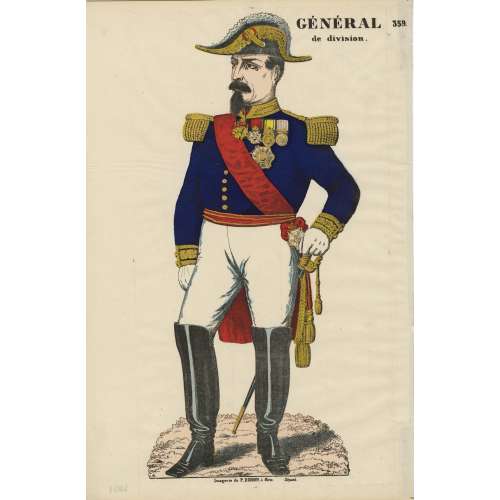 Hand-coloured woodcut on wove paper, 430 x 285 mm; black ink stamp “5051” to reverse. Top right: "GÉNÉRAL | de division." — "359." Bottom: "Imagerie de DIDION, à Metz. Déposé." Paulin Didion (French, 1831 – 1879) – publisher/printer.
Hand-coloured woodcut on wove paper, 430 x 285 mm; black ink stamp “5051” to reverse. Top right: "GÉNÉRAL | de division." — "359." Bottom: "Imagerie de DIDION, à Metz. Déposé." Paulin Didion (French, 1831 – 1879) – publisher/printer. -
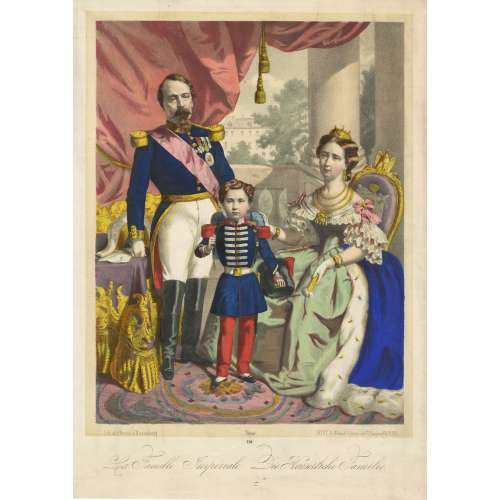 Hand-coloured lithography on wove paper, 395 x 280 mm; black ink stamp “5309” to reverse. On image: artist's initials "L. H."; on stone: "Lith. de Fr. Wentzel a Wissembourg. — Déposé — DÉPÔT, Fr. Wentzel Editeur rue St. Jacques 65, PARIS"; below centre: "239"; bottom : La famille Impériale. Die Kaizerliche Familie. Napoleon III [Charles-Louis Napoléon Bonaparte] (French, 1808 – 1873) Eugénie de Montijo [L'impératrice Eugénie] (Spanish-French, 1826 – 1920) Napoléon, Prince Imperial (Napoléon Eugène Louis Jean Joseph Bonaparte] (French, 1856 – 1879) Jean Frédéric Wentzel (French, 1807 – 1869) – publisher/printer.
Hand-coloured lithography on wove paper, 395 x 280 mm; black ink stamp “5309” to reverse. On image: artist's initials "L. H."; on stone: "Lith. de Fr. Wentzel a Wissembourg. — Déposé — DÉPÔT, Fr. Wentzel Editeur rue St. Jacques 65, PARIS"; below centre: "239"; bottom : La famille Impériale. Die Kaizerliche Familie. Napoleon III [Charles-Louis Napoléon Bonaparte] (French, 1808 – 1873) Eugénie de Montijo [L'impératrice Eugénie] (Spanish-French, 1826 – 1920) Napoléon, Prince Imperial (Napoléon Eugène Louis Jean Joseph Bonaparte] (French, 1856 – 1879) Jean Frédéric Wentzel (French, 1807 – 1869) – publisher/printer. -
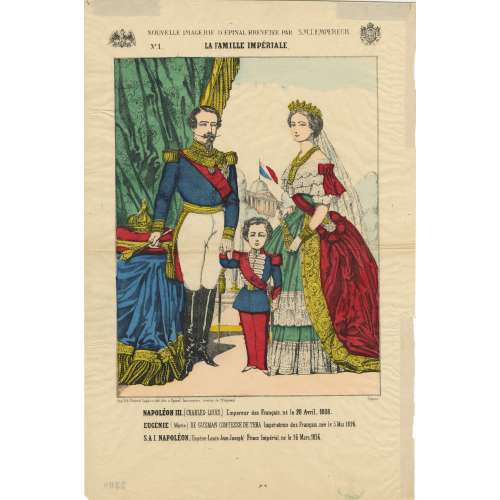 Hand-coloured woodcut on wove paper, 390 x 260 mm; black ink stamp “5308” to reverse; horizontal centerfold. Centre top: "NOUVELLE IMAGERIE D'ÉPINAL BREVETÉE PAR S.M.L’EMPEREUR" with imperial eagle and coat of arms at right and left. Below: "№ 1." — "LA FAMILLE IMPÉRIALE"; image in frame; under the image, left: "Imp lith. Pinot & Sagaire, édit. libr. à Épinal, fournisseurs brevetés de l’Empereur"; right: "Déposé". Bottom: "NAPOLÉON I. (CHARLES-LOUIS,) Empereur des Français, né le 20 Avril, 1808. | EUGÉNIE ( Marie) DE GUSMAN COMTESSE DE TEBA Impératrice des Français, née le 5 Mai 1826. | S.A I. NAPOLÉON. (Eugène-Louis-Jean-Joseph) Prince Impérial, ne le 16 Mars. 1856." Napoleon III [Charles-Louis Napoléon Bonaparte] (French, 1808 – 1873) Eugénie de Montijo [L'impératrice Eugénie] (Spanish-French, 1826 – 1920) Napoléon, Prince Imperial (Napoléon Eugène Louis Jean Joseph Bonaparte] (French, 1856 – 1879) Pinot & Sagaire (Épinal, 1861 – 1888) – enterprise, publisher/printer. Charles-François Pinot (French, 1817 – 1879) – publisher/printer.
Hand-coloured woodcut on wove paper, 390 x 260 mm; black ink stamp “5308” to reverse; horizontal centerfold. Centre top: "NOUVELLE IMAGERIE D'ÉPINAL BREVETÉE PAR S.M.L’EMPEREUR" with imperial eagle and coat of arms at right and left. Below: "№ 1." — "LA FAMILLE IMPÉRIALE"; image in frame; under the image, left: "Imp lith. Pinot & Sagaire, édit. libr. à Épinal, fournisseurs brevetés de l’Empereur"; right: "Déposé". Bottom: "NAPOLÉON I. (CHARLES-LOUIS,) Empereur des Français, né le 20 Avril, 1808. | EUGÉNIE ( Marie) DE GUSMAN COMTESSE DE TEBA Impératrice des Français, née le 5 Mai 1826. | S.A I. NAPOLÉON. (Eugène-Louis-Jean-Joseph) Prince Impérial, ne le 16 Mars. 1856." Napoleon III [Charles-Louis Napoléon Bonaparte] (French, 1808 – 1873) Eugénie de Montijo [L'impératrice Eugénie] (Spanish-French, 1826 – 1920) Napoléon, Prince Imperial (Napoléon Eugène Louis Jean Joseph Bonaparte] (French, 1856 – 1879) Pinot & Sagaire (Épinal, 1861 – 1888) – enterprise, publisher/printer. Charles-François Pinot (French, 1817 – 1879) – publisher/printer. -
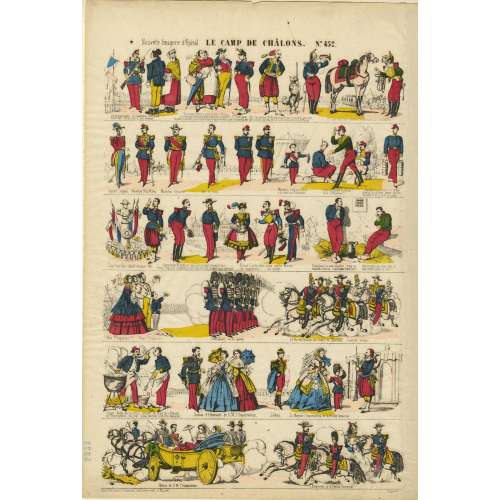 Hand-coloured woodcut on wove paper, 409 x 280 mm; black ink stamp “5323” to reverse; attached to the sheet 487 x 320 mm. Top centre: "LE CAMP DE CHALONS."; left: "Nouvelle Imagerre d'Epinal"; right: № 452. Bottom left: "Imp lith. Pinot & Sagaire, libraires edit. à Épinal"; right: "Déposé". Image: 6-tier cartoon with captions about Napoleon III and his son Prince Imperial (Napoléon Eugène Louis Jean Joseph Bonaparte; 16 March 1856 – 1 June 1879). Le camp de Chalons Pinot & Sagaire (Épinal, 1861 – 1888) – enterprise, publisher/printer. Charles-François Pinot (French, 1817 – 1879) – publisher/printer.
Hand-coloured woodcut on wove paper, 409 x 280 mm; black ink stamp “5323” to reverse; attached to the sheet 487 x 320 mm. Top centre: "LE CAMP DE CHALONS."; left: "Nouvelle Imagerre d'Epinal"; right: № 452. Bottom left: "Imp lith. Pinot & Sagaire, libraires edit. à Épinal"; right: "Déposé". Image: 6-tier cartoon with captions about Napoleon III and his son Prince Imperial (Napoléon Eugène Louis Jean Joseph Bonaparte; 16 March 1856 – 1 June 1879). Le camp de Chalons Pinot & Sagaire (Épinal, 1861 – 1888) – enterprise, publisher/printer. Charles-François Pinot (French, 1817 – 1879) – publisher/printer. -
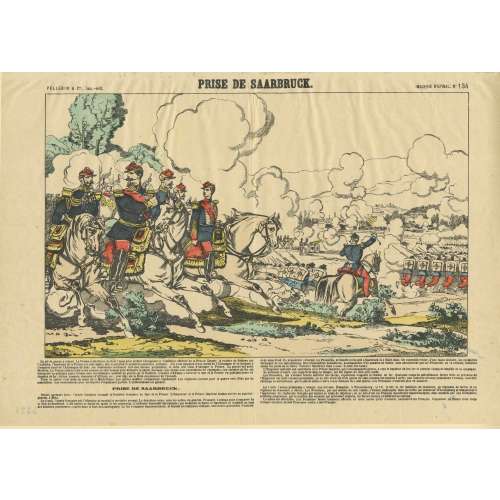 Hand-coloured woodcut on wove paper, 268 x 381 mm, vertical centerfold. On reverse: black ink stamp “5324”. Top centre: "PRISE DE SAARBRUCK"; left: "PELLERIN & Cie, imp. -édit."; right: "IMAGERIE D'EPINAL, № 134." Under the frame text starts with « La cri de guerre a retenti. La France a été forcée de tirer l’épée pour arrêter… ».[...] Prise de Saarbruck. | Depuis quelques jours, l’armée française occupait la frontière française en face de la Prusse.... Jean Charles Pellerin (French, 1756 – 1836) – publisher/printer. The Battle of Saarbrücken (2 August 1870).
Hand-coloured woodcut on wove paper, 268 x 381 mm, vertical centerfold. On reverse: black ink stamp “5324”. Top centre: "PRISE DE SAARBRUCK"; left: "PELLERIN & Cie, imp. -édit."; right: "IMAGERIE D'EPINAL, № 134." Under the frame text starts with « La cri de guerre a retenti. La France a été forcée de tirer l’épée pour arrêter… ».[...] Prise de Saarbruck. | Depuis quelques jours, l’armée française occupait la frontière française en face de la Prusse.... Jean Charles Pellerin (French, 1756 – 1836) – publisher/printer. The Battle of Saarbrücken (2 August 1870). -
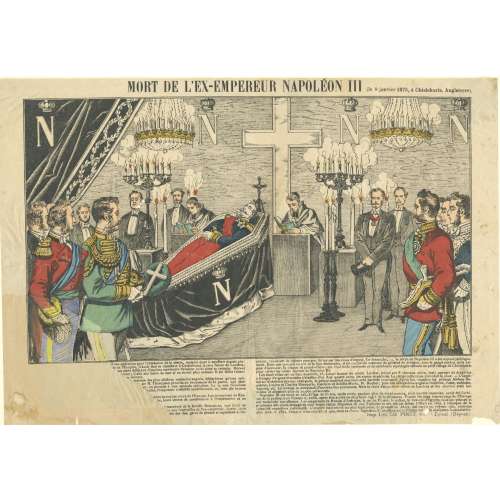 Hand-coloured woodcut on wove paper, 270 x 380 mm; attached to the sheet 303 x 442 mm with pencil ms inscription to the top left corner on the reverse: “Haye le 2-3-75”. Top: "MORT DE L'EX-EMPEREUR NAPOLÉON III (le 9 janvier 1873, à Chislehurts [sic], Angleterre)." Bottom right: "Imp. Lith. CH. PINOT, éditeur. Épinal (Dépose)". Bottom left corner of the image sheet torn and manually restored. Text partially lost, starting with « d’une opération pour l’extraction de la pierre, maladie dont’ il souffrait depuis plu-… ». See Chislehurst. Charles-François Pinot (French, 1817 – 1879) – publisher/printer.
Hand-coloured woodcut on wove paper, 270 x 380 mm; attached to the sheet 303 x 442 mm with pencil ms inscription to the top left corner on the reverse: “Haye le 2-3-75”. Top: "MORT DE L'EX-EMPEREUR NAPOLÉON III (le 9 janvier 1873, à Chislehurts [sic], Angleterre)." Bottom right: "Imp. Lith. CH. PINOT, éditeur. Épinal (Dépose)". Bottom left corner of the image sheet torn and manually restored. Text partially lost, starting with « d’une opération pour l’extraction de la pierre, maladie dont’ il souffrait depuis plu-… ». See Chislehurst. Charles-François Pinot (French, 1817 – 1879) – publisher/printer. -
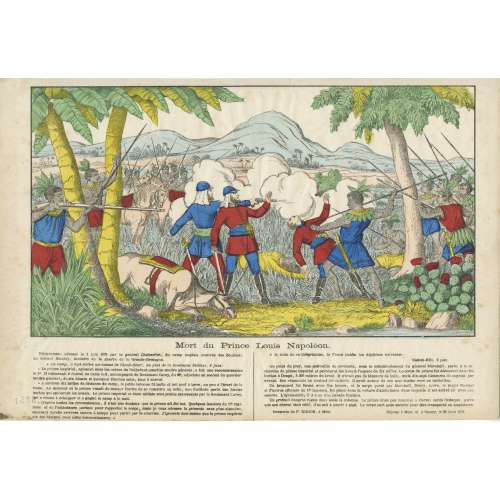 Hand-coloured woodcut on wove paper, 267 x 390 mm. On reverse: black ink stamp “5351”. Centre, under the image frame "Mort du Prince Louis Napoléon". Below left: "Télégramme adressé le 2 juin 1879 par le général Chelmsfort, du camp anglais (contrée des Zoulous), au colonel Stanley, ministre de la guerre de la Grande-Bretagne. « Au camp, à sept milles au-dessus de Blood-River, au pied de la montagne Stellezi, 2 juin: Le prince impérial, agissant sous les ordres de l'adjudant quartier-maitre général. a fait une reconnaissance le 1er. Il retournait à cheval au camp le 2 accompagné du lieutenant Carey, du 98e adjudant en second du quartier-maitre général. de six blancs et, quelques Zoulous amis, tous à cheval. A environ dix milles de distance du camp, la petite colonne fit halte at mit pied à terre, un peu à l’écart de la route. Au moment ou le prince venait de donner l'ordre de se remettre en selle. une fusillade partit des hautes herbes qui entourant les kraals. Le prince impérial et deux soldats sont portés manquants par le lieutenant Carey, qui a réussi à échapper et a gagné le camp à la nuit. D'après toutes les circonstances, il 'est pas douteux quo le prince ait été tué. Quelques lanciers du 17 régiment et de l'ambulance partent pour rapporter le corps; mais je vous adresse la présente sans plus attendre, espérant qu'elle arrivera encore à temps pour partir par le courrier. J’ignorais moi-même que le prince impérial eût été désigné pour cette reconnaissance. »" Below right: A la suite de le télégramme, le Times publie les dépêches suivantes: Stelezi-Hill, 2 juin. Au point du jour, une patrouille de cavalerie, sous le commandement du général Marshall. partit à la recherche du prince impérial et parcourut les kraals l'espace de dix milles. Le corps du prince fut découvert dans les herbes à Donga, à 300 mètres du kraal. Il n'avait pas de blessure de balle, mais dix-sept blessures de zagaies par devant. Ses vêtements lui avaient été enlevés. I avait autour du cou une chaine avec un médaillon. Un brancard fut formé avec les lances, et le corps porté par Marchall, Drury, Lowe, le mjor Stewart et d'autres officiers du 17e lanciers, fut. place dans la voiture d'ambulance dans laquelle il est arrivé ici avec une escorte. L'après-midi, il v a eu une parade funèbre. Un profond chagrin règne dans toute la colonne. Le prince n'est pas remonté à cheval après l’attique, parce que son cheval était rétif ; il se mit à courir à pied. Le corps part sous escorte pour être transporté en Angleterre. Bottom right: "Imagerie de P. DIDION, à Metz — Déposé à Metz et à Nancy, le 25 Juin 1879". Paulin Didion (French, 1831 – 1879) – publisher/printer.
Hand-coloured woodcut on wove paper, 267 x 390 mm. On reverse: black ink stamp “5351”. Centre, under the image frame "Mort du Prince Louis Napoléon". Below left: "Télégramme adressé le 2 juin 1879 par le général Chelmsfort, du camp anglais (contrée des Zoulous), au colonel Stanley, ministre de la guerre de la Grande-Bretagne. « Au camp, à sept milles au-dessus de Blood-River, au pied de la montagne Stellezi, 2 juin: Le prince impérial, agissant sous les ordres de l'adjudant quartier-maitre général. a fait une reconnaissance le 1er. Il retournait à cheval au camp le 2 accompagné du lieutenant Carey, du 98e adjudant en second du quartier-maitre général. de six blancs et, quelques Zoulous amis, tous à cheval. A environ dix milles de distance du camp, la petite colonne fit halte at mit pied à terre, un peu à l’écart de la route. Au moment ou le prince venait de donner l'ordre de se remettre en selle. une fusillade partit des hautes herbes qui entourant les kraals. Le prince impérial et deux soldats sont portés manquants par le lieutenant Carey, qui a réussi à échapper et a gagné le camp à la nuit. D'après toutes les circonstances, il 'est pas douteux quo le prince ait été tué. Quelques lanciers du 17 régiment et de l'ambulance partent pour rapporter le corps; mais je vous adresse la présente sans plus attendre, espérant qu'elle arrivera encore à temps pour partir par le courrier. J’ignorais moi-même que le prince impérial eût été désigné pour cette reconnaissance. »" Below right: A la suite de le télégramme, le Times publie les dépêches suivantes: Stelezi-Hill, 2 juin. Au point du jour, une patrouille de cavalerie, sous le commandement du général Marshall. partit à la recherche du prince impérial et parcourut les kraals l'espace de dix milles. Le corps du prince fut découvert dans les herbes à Donga, à 300 mètres du kraal. Il n'avait pas de blessure de balle, mais dix-sept blessures de zagaies par devant. Ses vêtements lui avaient été enlevés. I avait autour du cou une chaine avec un médaillon. Un brancard fut formé avec les lances, et le corps porté par Marchall, Drury, Lowe, le mjor Stewart et d'autres officiers du 17e lanciers, fut. place dans la voiture d'ambulance dans laquelle il est arrivé ici avec une escorte. L'après-midi, il v a eu une parade funèbre. Un profond chagrin règne dans toute la colonne. Le prince n'est pas remonté à cheval après l’attique, parce que son cheval était rétif ; il se mit à courir à pied. Le corps part sous escorte pour être transporté en Angleterre. Bottom right: "Imagerie de P. DIDION, à Metz — Déposé à Metz et à Nancy, le 25 Juin 1879". Paulin Didion (French, 1831 – 1879) – publisher/printer.



